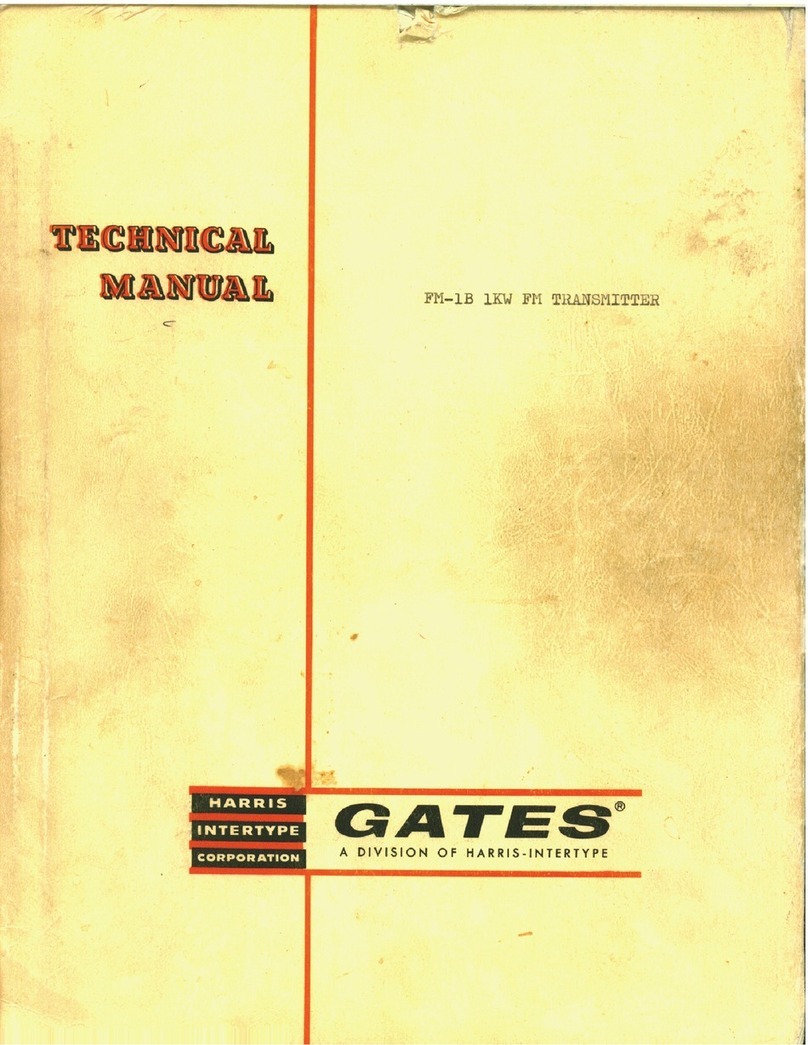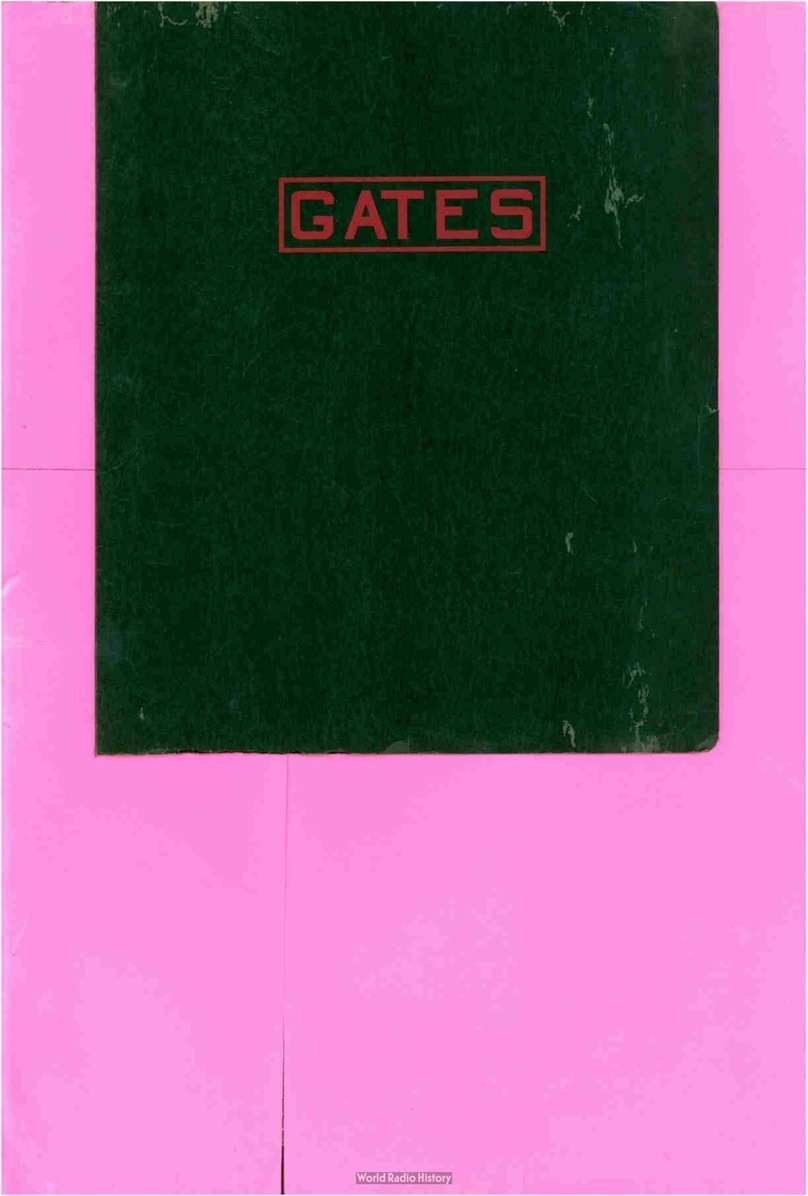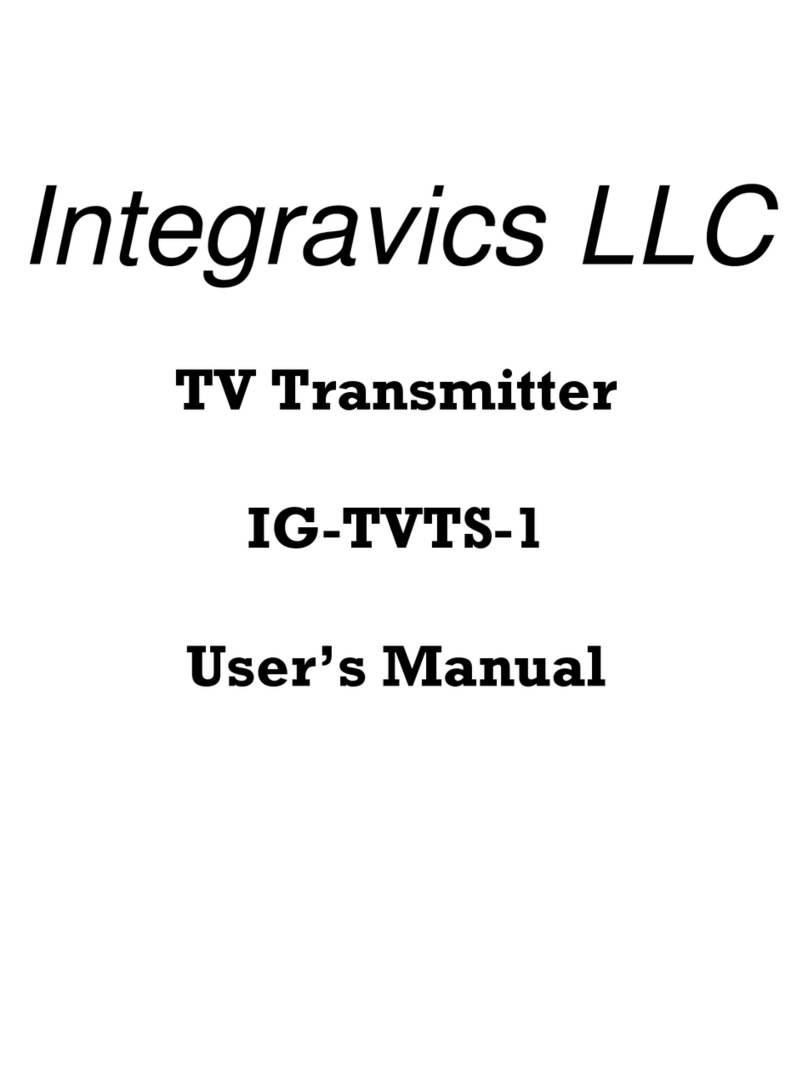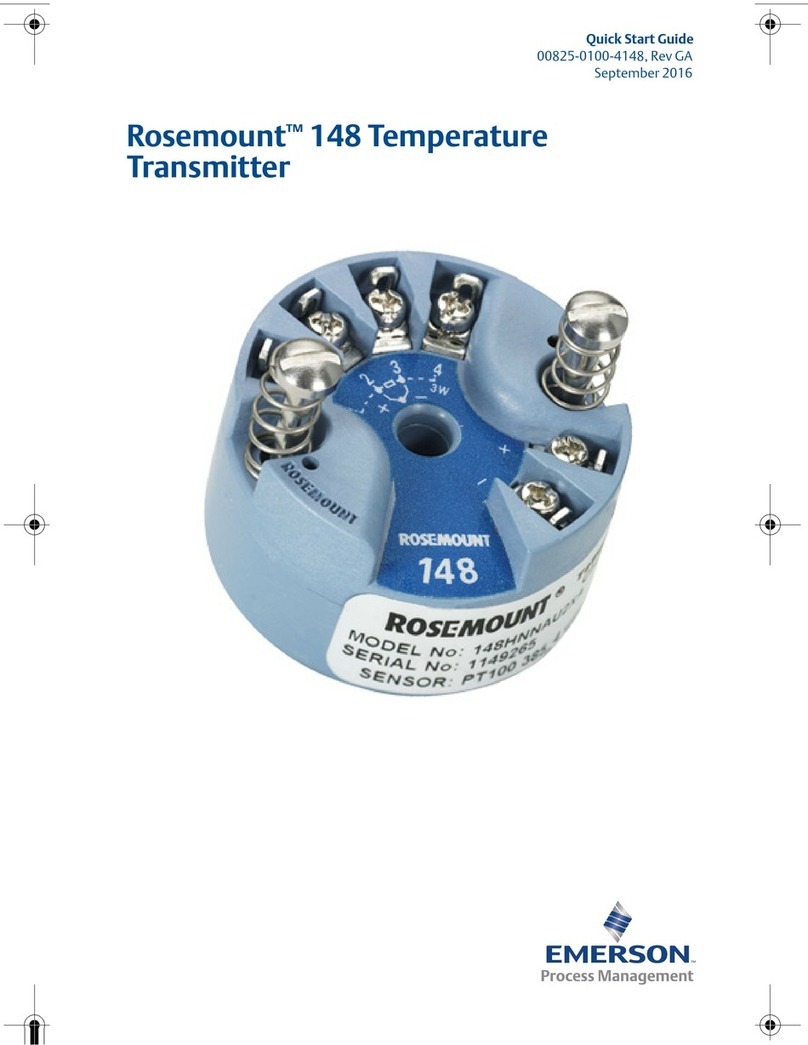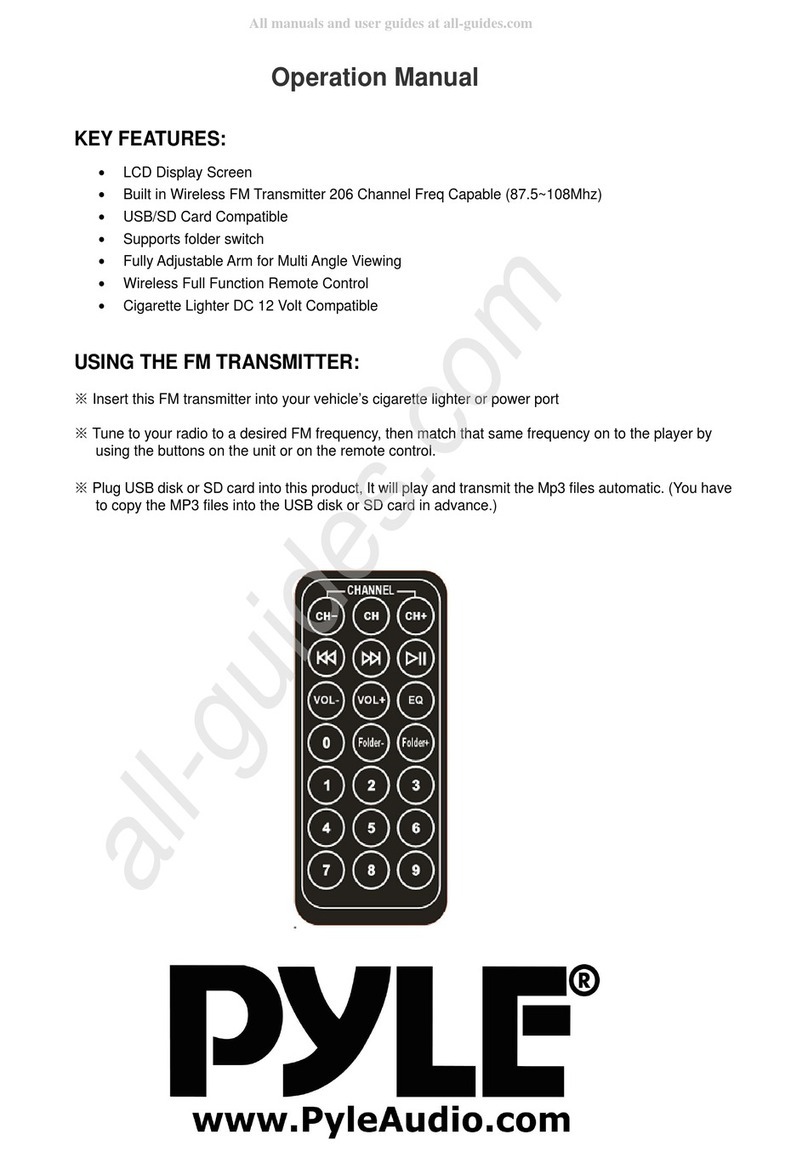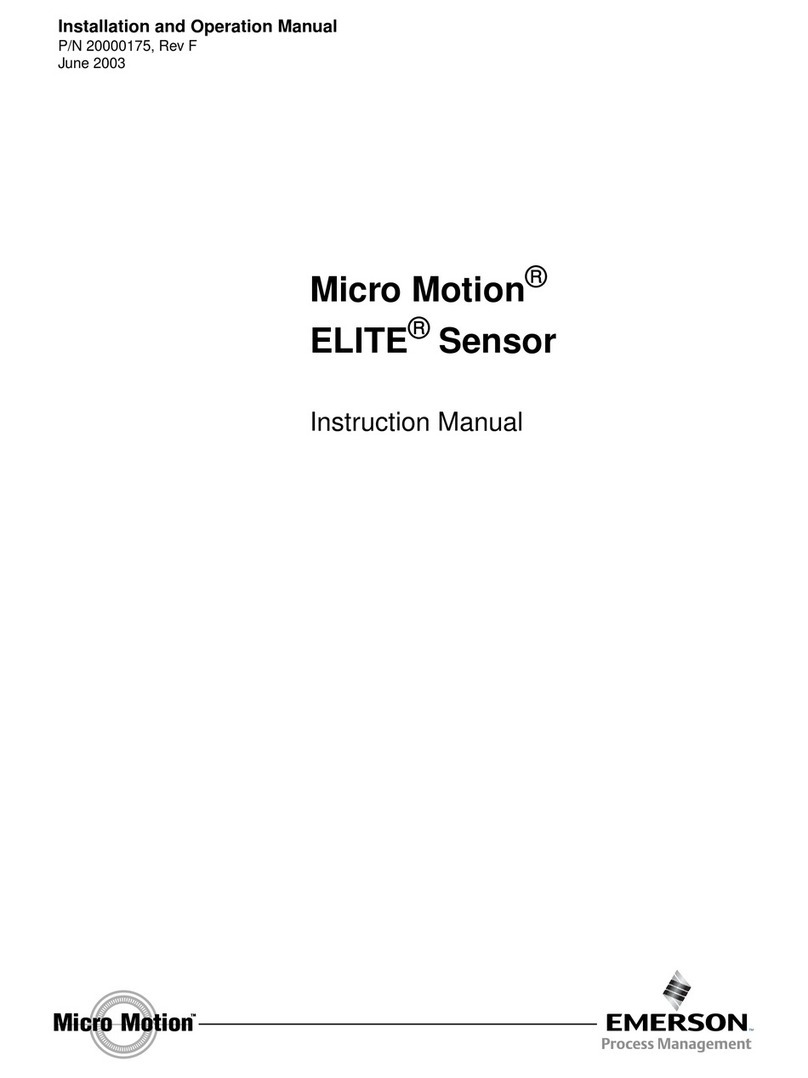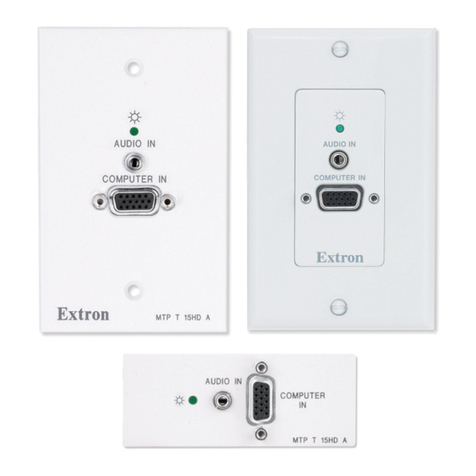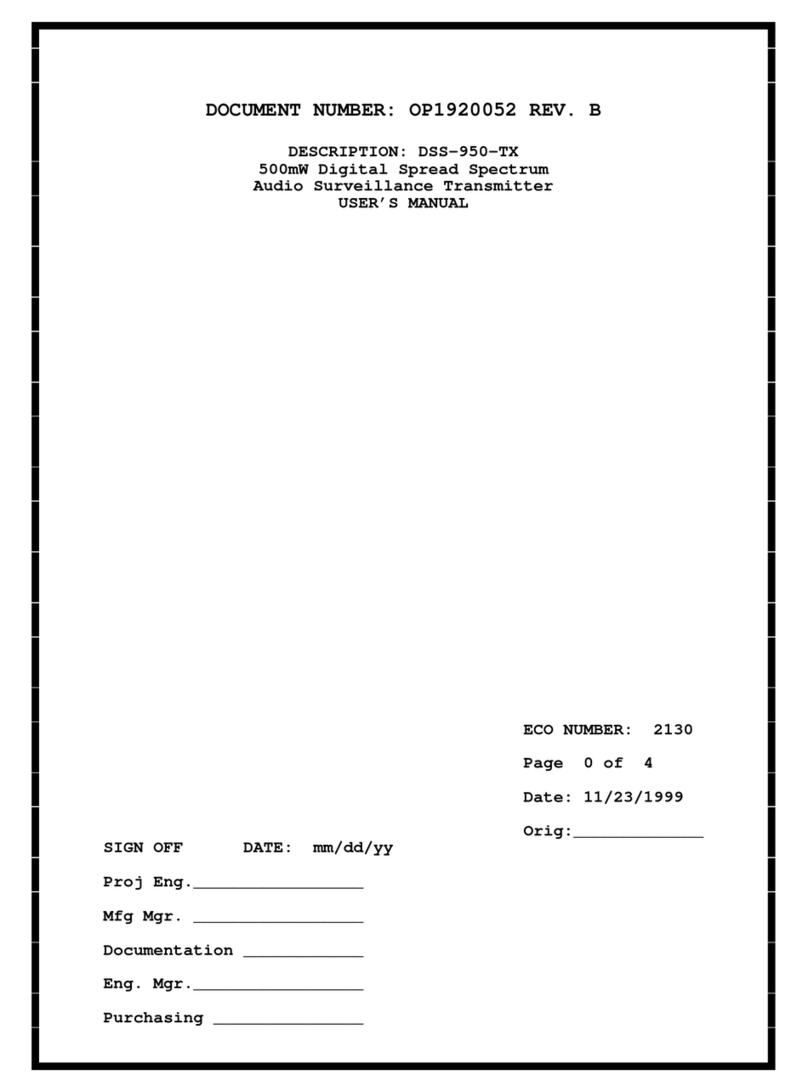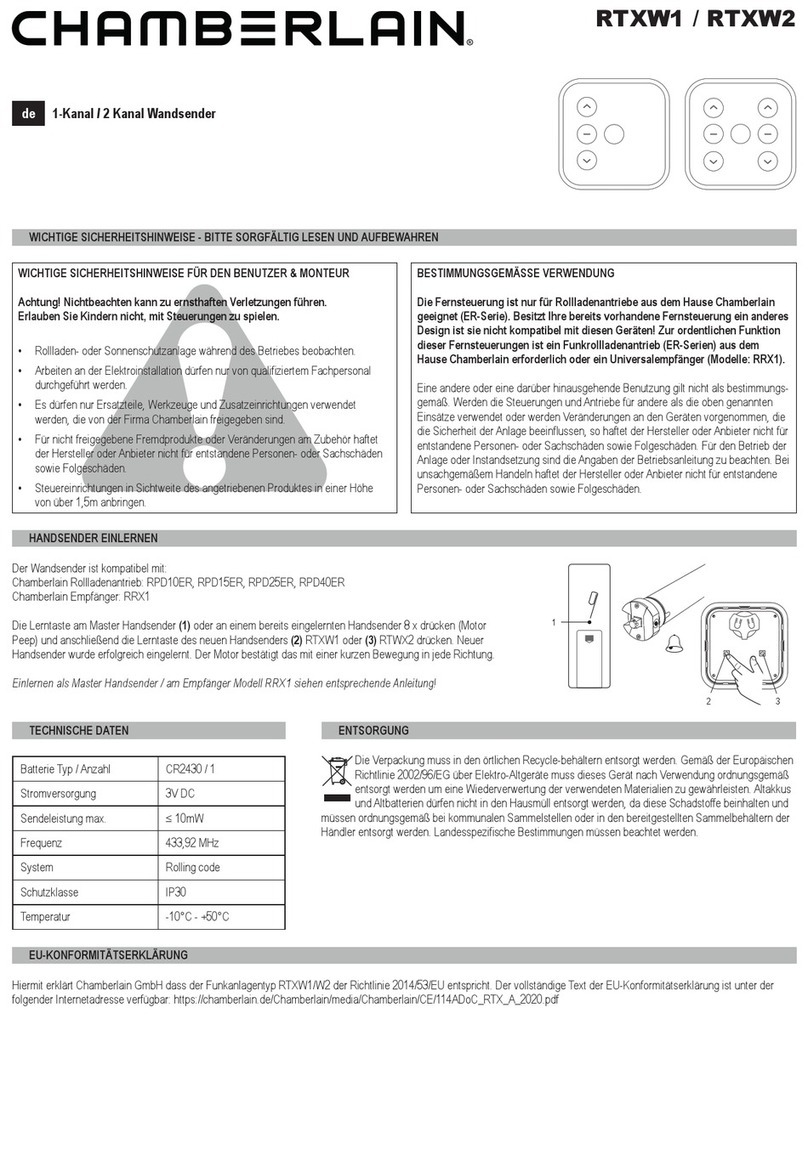Gates BC-1T Instruction Manual

www.SteamPoweredRadio.Com
I
., . A
L.•DI
fl
v:U,.L
lrJi<'(Jl-.)1ATI
l
1
t'I
r
OR.
iJC-1T
IN..,TrWCTION
BCOY
-'•
it
!'~S•.
TrF,!t ·,O'
IFli·,D
r·o~
COf'E.LHAD
OP1
'.,h/
,'I'ION 640KC/
,~5rJKC
-
C8-
?':
7
7
1'hi:-- c•t~nd ·
,rd
RC-1·?·,
1000
.
att
broad
ca.
t · er
nsmittf!'r,
has
b
en
mo<
ified
to
OD~t"Rt
on
th
Conelr
d
requency
of
640
KC. The
rh1nge
from
P'iQ
tr,
thfll
r-e
.~
1
l
larly
used
broad
ca
t,
fre'1ueney,
o
ths
Conelr~d
fr
quency
o
6M) K ·
•,
.srr.omoliRhed
pr&cti
•.
lly
in.
tant
neously
by
the
operat
on
of
e,.
_v
ral
RF
relays
•ithin
the
transmitter.
These
rel
vs
are, . 11 ·~ctu~
ted
h:,
me
.n~
of
r
n~
lever
r-w
itch
located
on
r,
,e
right
.:rn;j
s
de
o
th
,
t:r
n~-
mit
t~r
ad
Jac
~~t
to
th
to
molula~or
Li·s
control•
• A
nee
indicating
l,
.
.u1
,..
lncat-.ed
iust
&
hove
the
swi.
ch
i~
lit
when
the
freou•ncv
r i an,,-e
re-
]
.':t
y
are
in
tEe-
fe
6
ul
!.
·
posi
·ion.
· · 1
!..
.1Sl
:c..
tAl. vPr,n.-d"ING Pk.O(.;""lJUh.l -
..
In
0r
~r
to
1
·t
?.ntan~ou_ly
c
b·,
m
g~
from
one
frequer:cy
,o
an0
·
h,,r,
ne
BG
- " T
tr;;.r.-:;,r,itt"'r
ha
b
e1
~
"'.1~ified
a~
follows
-
-h
gecond
os.iJJ-~tor
ur.it
(:·~422
~icts
\
ef>n
jn-t
Jled..i.
An
ah1~-:i.:.11um
sh
lf
has
t "'en
mount
en
across
the
j n,..j
de
front
of
the
t.ransmi
t,PJ"
nd
on
hie~
shelf
thP.
Conelrad
oscillator
nc
the
re
6
7.1lar
fr•quen.y
orcil-
lator
{d
)O!~
C)
a re
rlac
d.
The
regu
ir
o~cilla
tor
normal
1
y
i::
loc-
....
d
on
th
. c .:s.,iel
an,j
!:'helf
arsl'!rr.lily.
It
has
o~
_n
r
moved
::\nC.
i.
mo1rnted
~
on
the
right
s
ide
of
the
ho~iz01tal
~helf.
The
Conelrad
o~cillator
i
to
t.h
e
lt<>ft
of
t,h
~
rep;ular
oscj
llc1
or,
on
the
same
shel
r.
'I'
.ese
osciJlar,or
make
u
of
cahles
which
are
pl•1gged
into
the
bac
·
side
ot
the
oscillator
cha
sis.
Thh·
makes
for
easy
r~:nov
J.
of
each
oscil
~tor
for
ser
icin~,
if
n~ceesary.
A11
fr-
quency
control
relays
a ·e
ener
izPd
by
th_
two
S"'t.s
of
cont·lct.s
which
:'Art'!
a
pa.rt
of
+..,he
latchinf
r
lay
Kl6.
Thii
late}
L
,?..
relay
L,
locat-ed
on
the
panel
and
she
f
assembl
y ,
on
the
right
hand
sir!e
of
tho
tran.
rr.itter,
ju
t,
below
the
os~illator
shttl.f.
Two
set
of
3inv,1e
,
ol
doubl
throw
contacts
on
this
latchin
g
rely
do
the
energi2ing
of
each
separa
e bank
of
frequency
s~l~ctor
reldy~.
The
coils
of
this
l
tchtng
r~J
y
are
energized
by
230
volts
AC
which
:ivailable
th1
ough
th~
lev
r
s~l~
tor
switch
Dq/,..9Al
if
th
0
filament
circ
1
J;\t
of
the
EC-1T
tran.,rr.it
t
is
de-energiz"d•
. A
pa
rof""norr.1aI!y
c!o-ed
contact"on
the
filam
n€
start
el~y
Kl
re
in
series
with
230
vols
AC,
the
lever
selector
~wi~ch
S9
1
S9A
~nd
the
coils
of
latchi
g
rAlay
Kl6.
If
the
filaments
ar~
off•
the
opera
ion
of
the
sel~ctor
switch
S9/S9A 11 entr-r ,
ize
on~
of
the
coils
of
the
latching
relay
16
{either
for
Coni'!lrad
or
regular
frequ
ncy),
t
lis
in
turn
will
rn~chanically
latch
n a
set
of
ontacts
which
will
cl
ce
th
AC
230
volt
circuit
to
ne
of
the
two
frequency
chan~e
bank
of
RF
relays.
(Thls
ci
cuitry
is
shown
on
overall
~chematic
C7:~o.,O
included
1
.-.1
1-
th!
s
nstruction
book.)
Bear
in
mind
it
is
imno~sj
J
~
to
chan
•
o~
rgti
~
f
enuencv
of
this
r&
emitter
wnile
the
oiat
or
ilam~nt
cir-
c~1
1~
en
r~ized:
This
Proc~dure
was
inco
o
·ated
to
make
the
ooe
a-
tin
fool-?r-oof,
it
cannot
be
swit,chr>d
with
any
h1
,h
voJ
age
apolied
,o
the
vario
cir
uits
of
ne
transmitter.
This
prec
udes
the
cossi-
bili
y
of
a-cin
co~tacts
•
.
,:
)
KC
oneration
th
following
rel
y
will
be
er
t'!r
~ized,
,
O,
'
'-' -
,.,
I
Tne~ r
lays
h
ve
en
~elected
by
the
op
r
tlo~
of
h
t
tr
n
,1
ter
filurn
n.
c
rut
d
-en
r_
z~d
at
~h
i
...
-

www.SteamPoweredRadio.Com
..
S9A
op.rat'on.
The
function
of
each
relay
of
this
group
will
be
d-
cr·ted.
1-lelay
K8
Is
-
used
to
swi
t
ch
the
two
o
ell
la
tor
units
that
are
a
part
f
thi
transmitter
into
the
~rid
circuit
of
the
6BG6G
RF
driver
sta~e.
A
set
of
double
pole,
double
throw
con
actn
perform
two
switchin
functions.
With
K8
nergized,
on1?
iLt
of
contact
connects
the
s:
0
KC
oscillator
unit
output
to
th(:;
i;rid
circuit
of
the
driver
sta
.,
,
as
m.
n-
t
ioned
previously,
the
othE"r
:=:et
of
contacts
switch
the
pla
e
vol
ta
;Je
to
the
850
KC
oscillator
unit.
Physically,
this
relay
is
located
on
th
panel
and
shelf
5
embly,
it
1 on
the
inside
of
the
ri
ht
hq
.
section
of
the
trans
itt
r .
Th
right
side
of
the
cabinet
mus e
remo ed
to
service
this
r
lay.
R
lay
1<9
i
located
just
below
th~
R~'
driver
coil
nd
behind
the
two
RI-,
driver
vari~hle
tank
condenger.
•
This
loc
tion
is
ju
:;t
to
tl.e
right
h nd
side
of
the
oscillator
mounting
shelf,
on
the
inside
o~ he
trans-
mi~ter
car.in~t.
This
relay,
when
ener
ized
or
S50
KC
operation
co -
n
-C
s
the
variable
condenser
C7
and
it
p
dder
corn1ens
r
Cl
5
;_
"'~•c,r.s
th
eoil,
L8
and
when
a.d.'usted,
Will
tune
the
HF
driver
s
a.er@!!
to
~r::')
KC.
Relay
KiO
iR
loc
t
d t
the
1
ft
hand
sid
of
th
P.A.
tank
coil
Ll2
(when
transmitter
i viewed
from
the
rear}.
With
thi~
relay
ener
gir. d
for
850
KC
operation
its
contact
romplete
the
v
riabl
tap
or
rotat
4
n ,
whe
1
circuit
of
th•
PA
tank
coil
Ll2.
This
varia
le
connectj
on
i"
made a a
i
lable
to
the
o
era
or
by
mean~
of
the
un .n.
knob
located
· n
th~
front
panel,
m~rked
P.A.
Tune.
This
control
11~ s
th
P.A.
coil
to
be
tuned
to
r~sonance
at
P50
KC,
th~
re~1lar
operating
frequ~ncy.
Rel
y
Kll
is
locat
d
in
a
row
of
relays
t
the
very
ton
of
Uie
cabinet
and
is
available
for
servicing
by
removing
the
rear
cabinet
cover.
T1is
relay.
when
energized,
compl~tes
the
RF
c
rcuit
bet
·een
th~
output
o
P.A.
t,~1nk
coil
L2
an
the
input
of
load
int
coil
113.
Rely
Kl2
is
located
on
the
in91de
left
hand
ortion
of
he
ca
,
1net,
very
near
the
output
connection
of
coil
Ll4o
Thi~
r~lay,
when
en
r~ized,
completes
the
RF
circuit
between
th
output
of
coil
114
and
the
input
of
modulation
onitor
pickup
coil
Ll5.
en
this
transmitter
is
in
the
S
~orc
''reful"r"
operating
po~it1.on,
the
various
relays
eet
up
the
output
circu
t so
as
to
use
~11
,hen
t-
works ,
hat
are
normally
used
in
the
scanJard
BC-lT
tr4nsmitt
r.
Thi~
network
has
proved
itself
to
t,e
e,ctremely
~atisf
ctory
for
m·
tchin
the
P.A.
tubs
to
he
51.5
ohm
lo~u
and
at
th
same
t1m~
to
di~criminate
~ainst
harmonics
that
might
be
gener
ted
in
the
fin
1
amplifier.
A
small
n
on
indicating
lamp
is
ountPd
irectly
ahov@
the
fre
u~ncy
change
witch
S9/
9A
.
This
neon lamn
is
ener
ized
when
the
witch
·o/
S9A
is
mov!'d o
the
top
nosi
..
ioni
mark
d '
1
Reg.".
Thi-;
indicates
to
h
opera
or
that
the
l
tching
r ,
ay
Kl6
is
in
the
1
51KC
operat
. n
p
sition
and tht'!
transmitter
will
be
ready
to
be
energized
to
produce
]
ro
w·tts
carri
rat
thi
frequoncy.
T .,
no
...
nal
tuning
proc~dure
wi
1 b
followed
s
described
in
the
stan-
~
d
rd
1n
truction
book
for
opP.ration
o
this
transmitter
on
~~O
KC.
or
oper~tion
on 640
KC
the
Con_lr
ft~que
cy,
th
rel1ys
mention
d
abov
d
.-en
rgized.
At
1-,he
s
me
im~
rel
ys
Kl3,
Kl4
and
Kl5
will
n n
.t
1is
c<1rni:ination
of
E!nt'rg·
'."..ed
and
d
-energi
zed
relay
1.,'-2277

www.SteamPoweredRadio.Com
..
w
11
t
natle
h
trans:rit:ter
to
instantan~ouslr
develop
1
r:,,;
(')f
:)lJr:,
,
,ut
c,~r
Gn
6l0
KC
.
In
the
following
pdragrarhs
a
descrip~ion
of
t
~e
elar~
ac~ion
or
640
KC
operation
wtll
be
de·cribcd.
e
Oscill
tor
c
ange-ove
r
relay
K8
i~
de-enerr,izad
.
In
thi~
position
thr-
dou'"1
l e
oole
doubl
throw
set
o.i.
contacts
have
disconnected
the
:~50
KC.·
oscillator
power
nd
output
circuits
and
have
now
set
,rn
th
clrc'..d,t
J
of
the
,.o
KC
oscillator
.
This
6 0 K
outp.1t
ir
heint~
fed
into
thP
~rid
circ·
it
of
the
,
.RF
driv
r
sta~e
.
'
rhe
RF
driv
r
ank
cond
nser
change-over
relay
K9
is
de-energiz
d.
Thi::'
automaticat
1,
cUeconnects
C7 anc
Cl5
and
1
th
ir
plac~
the
V.:iri
nle
condrmser
C26 and
padding
conden
er
G27
havft
been
comP.~teL
Thdse
condensers
will
tun
the
RF
buffer
coil
1$
to
the
Conelr!ld
fr
-
qu
ney
of
640
KC
. Once
these
cori<lensers
a e
')rop(~rly
tune
i
t.
.is,
of
cc
urse
, no
:-,robl
m
to
~wi
td·.
from
850
KC
to
640
KC
im,-n(
dia
·.el
v t
ean
of
relay
K9
.
In
the
power
amplif
i
er
St>
C
tion
of
the
transmitter,
t h
(~
relny
KlO,
Y.ll
and
K12
t,ave
been
de
-
energized
.
A:,
the
sarn.e
time
relays
Kl3
1
Kl4
and
Kl~
have
b en
ene
r
ize
d.
Thi~
relay
act.ion
sets
up
the
am
_
l1fier
for
640
KC
opt-ration.
It
will
't
.
noted
that
f or 640
KC
op,..ration,
the
ot..t
...
rut
circuit
configu
r
ation
has
been
simplif1Pd
to
just
a
common
ttFI•,
3ljpht
tuning
of
this
ci
rcu
i t
is
pos
itle
by means
of'the
s~ries
n-
ductor
Ll6,
the
knob
of
which
js
loc
~
ted
at
the
v ·
ry
top
of
~1e
ca
btnet
nenr
th~
door
~top
.
Rel
y
Kl0
i~
de-energi.zed
.
This
opens
the
variable
coll
:,
r.c.,i't
circuit
and l l ows
the
coil
inductance
to
be
increased
ae
now
thP.
ircuit
mE:Ak
s
u
se
of
th
e
ad
di
ti
on
al
tu
rn
s
which
are
betwe
n
he
var
.
~a
t
l~
wh~,.J I
ap
and
the
C
on
el
rad
f i
xe
d t
ap.
(Late
r
on
,
the
inform
-
3.tton
for
loci:.ting
this
tap
will
be
given
.)
Relays
Kll
and
Kl2
are
de
-
,mere;ized.
This
action
automat1cr1.J
y
dL
-
conn
ct
11'3,
Ll4.
ClJ
and
C_J4
from
the
output
circuit
.
The
~ner~ized
relays
Kl3,
Kl4
anJ
Kl5
now
set
up
the
outru
circ
u
it
for
operation
on
th~
640
Y.C
Con
lrad
fre.quen
Yo
Kl3,
bt!!!ing
P.
er-:;i.1,ed
now
conn<~cts
Cl~
And L16
acros
, e nor-i,a l
P.A.
t,ank
coridens
rn
Cll
"'nd
Cl:2.
Th:is
adds
another
ao,rox1mate
2~0
1nmfd.,
to
the
VrllUEI
of
P.
A.,
t .k
condensers.
As
t.r
1
ere
wer
two
400
mmfd.
conr\('n:.;"!rs u
.:
ed
f'
o 810
KC
1
this
makea
10w
a
to
al
cap
c-i
ta
nee
of
.0010)
mf
d.
used
f
or
,
.,.
.J
KC.
This
approx
:i
r.iate a
,t
c,.
"
of
10
.
or
the
P.
A
..
R
lay
flt
1-
~ne:gized
hich
places
the
loadin~
c~
ndonuer~
Cl6
and
Cl?
into
rne
•>utpit
cjrcuit
.
These
-::ondensers
w r s e
lec
t.
ed
o
.:-·ti
,.,
:·1c
)ri'y
1 ,,d t.r!e
amolifier
into
re
istive
51. 5
ohm
loa
c
l.
If
tL
e ic
tr
l
"orc
,h·
i.·n
oa<i
is
(1iff
rent
than
:;1.5
o
hm
.;
(with
no
ro;:ctanc
t!
v1r
an,
,
!-er-
v-
lu
of
outpu
t
conden
f"
r
":'IU$t
he
H~l,ct
, <l.
PP
· y ¥ l
:"
i.i:-.
ene
gi
ed
which
co
mpl0tes
th
e o,1t
;,
ut
ci
.r<'uit
to
th"'
e..:ter
&
:1
.F.
loH
~.
t'
~~~
comol~t~s
the
~Pqu~nce
of
op~ration
~or t
he
varic
u~
r•l
ye
th
3t
are
u~
j
in
~~i1
tr~nfmitt~r.
C':.;
-
2277

www.SteamPoweredRadio.Com
•
..
• •
n1r;,
· • e
1q
t·
1,t
t'
, ct j
he-
+·
cl
l .
;,
;
~
n
r
h,t•
n.·
"
• __, ..
;.
•~.
t
t
"'
--
o
ta.-
c.
o
il
,
0<1
u
t
n·
1
.•rn
y
n t
hr-
,
....
t
1.
•
. , · • <i f
I
y
rm~
r
<'ti
'ier
tu
:--
r,
B
1~
Ql_ -,,
f'
ct
i
+>
i
"'r
•
,!.!1
fill
r
e
~
C d:--i
~
,
the
,o
ei·
arr1
f-
1
"'.fit
r
of
ap
ximate
y
120
to
l"O
na
tr
e
r-.
•
~.
la.·
,~ "U rf:.'lnt
sho
ild
d
:!.p
tQ
a r
oun
200
rnA
t
10)0
vo.,
ts
if
...
h-
ei
re
t
is
co
·~ctly
tun
d,
Th
ifl
can
he
checked
by
r.utt.in~
d,..·wn
+n
co~pletely
·nd
~ovin~
the
fi
ed
ta
. on -
.A.
coi
Lli
turn
ta
~imo.
Tr
trans
itt
r back on
an
check
the
P.A.
plate
curr~n.
P
ac
r,
he
a o
c,n
th.
tu
n
o"
the
c 1
that
gi! ..
~a
th
lowt'
..
t
p
late
urre
r
t.
re
a.
djng
...
L!s_s
te
tra.sr.dtt_:_.r
i
•:
or
+·
br.:
.--
v'"'.
ton
d~
-:..:.~
i
.l
r.
·il
f t
r
thi~
t~p
1-o
·
•ition
ha3
b
en
lo
,
ted
~
Q.2?!!!
~
...
~
...
~-a
....
n_~
__
.;;;__,........,.
__
__...
_________
.
J
1
~i r.~
....
ur
11
YCtltag
~
ar~
of
f,
c;.ir~r,111.y
revlace
tht"rect
.
:l:>
1
••
ci
...
t
H.t
h
r;.
ct
b
~en
pr
V
.L
ously
rernovP-d.
Agaih
s t rt
uo
the
tro.n,
,,l
t.,
r . h
po
er
am
_
lifier
should
b
e;
dr
·1n
fr
appro
• 550
to
6oo
ma.
'lt
·,
round
2t
00
·o t s .
his
would
b . a
normal
in
ut
for
the
onelrn1i,
1/
JO
~C
i:
os
l.;
·or.
Slie;ht
tu
ing
adjustm
nt
c
n
be
rn&de
by
varying
th
i,
.:.
du
ctor
Ll6.
Th.
ariou
s
,...elays
d
othPr
compon"nts
h
ve
een
atfe<
uat~
y •-
;te
r
ell)
d
to
conform
,
◊
the
ov
•r
11
Gate
s '
~ma
-1
,
dw
_
g;
C
-"
6,
PO
:
md
tc
h~ a,
.-
ditior.a}
?a
.s
ljst
that
s
p~rt
of
this
instn1ction
book.
For
s1-i1
p
't
nent
the
v
rious
rel
ys
and
oth
r
com
.nent
hav•
be
r,
·
1ea
do~!
o
...
. u
p_
o• ·
teci
by
packinv
111ateri·
l.
B,
sure
o
chec
th..,
compl
te
trana-
'
itter
:rnd r move
11
o"
th
mat~rtal..
Check
thorou~
,
hly
at
the
ve
top
of
the
tran
mitter
i
the
~n
compar
ment.

www.SteamPoweredRadio.Com
ADDENDA
0HEET
BC-1
T
TR,L\JM.ITT
.£R
WITH
CONELRAD
SWITCHING
CS-2277
C28,
P.A.
Padder
for
Conelrad
frequency
has
been
removed
for
shipment.
It
will
be
necessary
to
remove
the
Fan
Assembly
in
the
top
of
the
trans-
mitter
to
install
this
capacitor.
This
transmitter
is
equipped
with
silicon
rectifiers
per
customer's
specification.
2/28/61
GATtS
RAJIO
COMPANY
QUINCY,
ILLINOIS

www.SteamPoweredRadio.Com
•
•
;1.
DD
EN
DA
,3
H
£~
T
For
BC
lT
:B;or
BC
500T
Reference
833A
Tube
Handling
The
Ga
tes
BC
lT
and
its
compa
n
ion
transmitter
the
BC
500T,
use
83
3A
power
tubes
in
the
modulator
and
power
amplifier
stages.
These
are
of
the
single
wire
or
thread
filament
type,
as
com-
pared
to
othe
r
tubes
that
may
have
the
filam
e
nt
(heater)
con-
tained
in
a
tube,
which
is
com11only
called
the
cathode
assembly
.
Tubes
ha
ving
filam
e
nts
su
pp
orted
by
springs
(such
as
the
833A)
require
more
than
normal
car
e
in
handling.
These
filament
wires
are
easily
broken
by
sudden
he
avy
vibration.
At
all
tim
e s
han-
dle
the
tubes
with
care,
until
they
ar
e
safely
ins
e
rted
in
the
tube
sockets
of
the
transmitter.
At
this
point,
more
car e
is
required
as
the
two
filament
prongs
are
also
the
me
ans
for
securing
the
tubes
in
the
transmitter
.
l"iake
sure
th
e
conn
ec
tions
have
some
"give"
so
that
no
u
..
~
due
strain
is
p
l~ced
on
the
glass
to
metal
seal
. As
these
tubes
do
expand
a
bit
during
op
e
ration,
the
two
securing
filam
e
nt
connec-
tors
must
be
able
to
mov0 a
bit
themselves
.
Tak
e
car
e
when
making
the
grid
and
p
late
conn
e
ctions,
do
not
put
any
undue
strain
on
th
ese
connections
also,
during
tube
installation.
Of
cours
e
the
connections
of
th
e
grid
and
plate
should
b e
fl
e
xibl
e
to
al
low
for
expansion
of
the
tube.
For
shipping
or
storing
it
is
a
dvisable
to
us
e t he
packing
material
and
ca
rton
that
the
tube
was
shi
p
ped
in
from
the
tube
manufac-
turer.
·
Following
th
e
se
reason
a
bl
0
precautions,
ther
e
should
be
no
trouble
in
handling
th
ese
tubes
•
2/17/61
-1-

www.SteamPoweredRadio.Com
•
•
INDEX
Page
AIR
FILTERS
........................
.
..
.
.........................................
;........................
7,
9
ANTENNA
COUPLING
••••......... .
.........
•..•..
..
.....
..
•
............
...
.. ...
••
.••••.
...
.•
.....
..•.•
7
AUDIO
INPUT
.............................................................................................
3
CRYSTALS
AND
ADJUSTMENT
...........
..............
...........
......................
.
..........
Z,
7
DUMMY
ANTENNA
................................................
_.
.....................................
4
FEEDBACK.............
.....
........................................................
..
....................
3
FILAMENT
RHEOSTAT...............................
..
..
..
.............
..
.............
......
.........
7
FLOOR
WEIGHT
..
.............
..
... .
...
...•..
......
..
.•.
..
.
..
.. ...•
..
..................
...
..
.
..
...
.....
. l
FREQUENCY
MONITOR
..............
•••
..................
...
..................................
....
..
. 3
GROUND
SYSTEM
..................................................
.....................................
Z
INTERMEDIATE
POWER
AMPLIFIER.....
..
..........................
.
..........................
3
METERS
....................................................................................................
7
MODULATION
MONITOR
........
.
.........................................................
.......
.....
3
MODULATOR
BIAS
,
ADJUSTING
.................
..
......................................
...
........
3,
6
NEUTRALIZING
..........................................................................................
3,
5,
6
PARTS
LIST
......................................................
.....
................
.
........
.....
......
10,
11
PLATE
RHEOSTAT
.......................................
...
....
............
.
....
...
...............
..
.. 7
POWER
AMPLIFIER
AND
TUNING
...
..
........
....
..
.
...
....
..
...............
...
....
•..
..
.•
....
..
.
3,
6
POWER
SUPPLIES
:
HIGH
VOLTAGE
.........
..
...
...................
:
.........
-..
.......................
.......
....
4
INTERMEDIATE
................................................................................
4
MODULATOR
BIAS
............................................................................
4
PRIMARY
LINE
...........................................................................................
Z
PROTECTION:
MODULATOR
...
•.
...•..
...................
...
........
.................
.......
........
..
.
..
.
...
..
3
POWER
AMPLIFIER
..
...
......
..
....
•
..
..
..
.
..
....
..
..
..
.
..
.
..........
....
....
.
..
..
..........
3
RELAYS...............
.
........................
.
.......................
...........
.......
..
......
3,
7
READYING
CHECK
LIST
.........................................................................
,
..
•
..
4
REMOTE
CONTROL
............
.•
.............
....................
....
...........
...
..........
.........
1,
4,
8
SPECIFICATIONS,
TYPICAL
................
...........
......
....
.......
.
..................
...
..
.....
I
SUCTION
FANS
...........................................................................................
1, 7
TEST
EQUIPMENT
......................................................................................
7
TRANSMITTER
BASE
.............
..................
.....
..
..................
.
..........................
Z
TUBES
.......................................................................................................
1
TUNE-UP
PROCEDURE
................................
.....................................
.....
.•.
...
4,
.
5,
6,
7
VOLTAGES
AND
CURRENTS
................
,........................................................
6,
7,
9
GATES
RADIO
COMPANY
-
Quincy,
Illinois,
U.S.A.

www.SteamPoweredRadio.Com
•
INSTRUCTIONS
FOR
INSTALLING
AND
OPERATING
THE
GATES
MODEL
BC-lT
lKW
BROADCAST
TRANSMITTER,
M5393
IB-869A
In
the
preparation
of
this
instruction
book,
we
have
endeavored
to
be
concise,
yet
thorough.
In
several
places,
symbol
numbers
are
referred
to,
such
as
R 1
or
S 1,
etc.
These
symbol
numbers
will
be
found:
(a)
on
picture
illustrations
in
this
book,
(b)
on
the
wiring
diagrams
in
this
book,
(c)
adjacent
to
or
on
the
part
itself
in
the
equipment,
and
(d)
on
the
Parts
List.
Symbol
numbers
follow
industry
standard
procedure
and
have
a
mean-
ing.
"R"
means
a
resistor
or
rheostat,
"C"
is
always
a
capacitor,
"V"
a
vacuum
tube,
''S"
a
switch,
"K"
is
always
a
relay,
"L"
is
an
inductor,
either
air
or
iron
core,
etc.
As
you
read
this
book
and
it
might
say,
"Adjust
Ll2
to
resonance".
Find
Ll2
on
the
picture,
which
in
this
instance
is
picture
M5393,
and
you
quickly
understand
what
to
adjust
and
also
gain
familiarity
at
the
same
time.
--
You
will
find
this
equipment
a
pleas
-
ure
to
install
and
not
nearly
as
difficult
as
the
length
of
the
instruction
book
might
indicate.
Instruction
books
are
reference
manuals
for
both
installation
and
future
servicing.
IMPORTANT
...
If
this
transmitter
is
to
be
unattended,
i.e.,
operated
by
remote
control,
care
should
be
taken
that
winter
temperatures
inside
the
transmitter
building
do
not
go
below
50°
Fahrenheit.
Mercury
vapor
recti-
fier
tubes
will
arc
back
at
low
temperatures,
often
causing
serious
damage
to
other
expensive
components.
Protective
relays
and
blower
motors
may
also
become
sluggish
under
extreme
cold
conditions.
Failure
to
provide
adequate
winter
minimum
building
temperatures
will
void
the
guarantee.
THE
FOLLOWING
SPECIFICATIONS
ARE
TYPICAL
AND
MAY
VARY
SLIGHTLY
WITH
VARIOUS
MODES
OF
OPERATION:
1.
Rated
power
output
:
1000
watts.
Capable
of
1100
watts
where
directional
systems
induce
losses.
2.
Frequency
range:
1600
Kc
to
540
Kc
at
the
frequency
you
ordered.
3.
Power
input:
230
volts,
single
phase,
either
50
or
60
cycles.
Provide
#4
or
larger
primary
wiring
from
entrance
box
to
transmitter.
Transmitter
will
con-
sume
approximately
4000
watts
at
100%
modulation.
4.
Frequency
stability:
t_
10
cycles.
_
5.
Audio
input:
12
db
f
2
db
for
100%
modulation.
The
output
of
a
Gates
SA-39B
limiter
should
be
correct
for
this.
If
other
limiter
or
audio
amplifier
used,
be
sure
and
check
output
capabilities.
/
6.
Input
audio
impedance:
Ai,
supplied,
600
ohms,
which
will
also
match
500
ohm
impedance.
It
may
be
connected
for
150/250
ohms
if
desired.
7.
Distortion:
Rated
at
3%
from
50
to
10,000
cycles
but
capable
of
much
better
at
many
frequencies.
You
will
be
pleasantly
surprised.
8.
Noise:
60
db
or
better
below
100%
modulation.
9.
Carrier
shift
:
3%
or
less
between
O
and
full
modulation
provided
wire
size
in
Point
3
(above)
is
followed
and
R.F.
load
is
correctly
tuned.
10.
R.F.
output
impedance
:
Will
match
loads
from
50
to
70
ohms.
An
antenna
coupling
unit
ii;
usually
necessary
to
match
the
antenna
tower.
Gates
Radio
Company
OTHER
HELPFUL
DATA:
(a)
Provision
for
2
vacuum
type
crystals
and
holders.
If
you
wish
a
spare,
order
M5602,
giving
your
frequency.
(b)
The
inbuilt
dummy
antenna
will
accept
100%
modu-
lation
and
is
for
51.5
ohms.
See
Par.
4
under
"How
Can
We
Helr,
You?
"
in
the
back
of
this
manual,
entitled
'Computing
Power
Output".
The
dummy
antenna
is
substituted
for
the
tower.
(c)
THE
TWO
TOP
SUCTION
FANS
can
do
their
best
in
cooling
performance
by
periodical
replacement
of
the
removable
air
filters
located
at
the
front
bottom
of
the
transmitter.
Order
Type
M5825
and
two
are
required.
The
time
cycle
in
replacing
filters
depends
on
dust
conditions.
Normally
about
three
times
annually.
(
d)
The
floor
weight
is
800
lbs.,
or
slifhtly
leas
than
100
lbs.
per
square
foot.
Allow
28
'
for
the
front
door
swing.
Size:
78"
high,
36-1/16
."
wide
and
31-7/8"
front
to
back.
(e)
TUBES:
Your
100%
tube
complement
(TK287
if
you
wish
to
reorder)
is:
(2)
(6)
(4)
(2)
(2)
( 1)
12BY7A
for
oscill,ator
and
first
intermediate
amplifier.
6BG6G,
of
which
two
are
parallel
operated
as
the
second
intermediate
amplifier,
\wo
are
push-pull
audio
input
amplifiers
and
two
are
cathode
follower
driver
amplifiers.
833A
tubes,
of
which
two
are
R.F.
power
amplifiers
in
parallel
and
two
are
Class
B
modulators.
8008
main
power
supply
rectifiers.
866A
intermediate
power
supply
rectifiers.
5R4GY
bias
supply
rectifier.
I~
you
wish
FCC
spare
tubes,
which
is
-
the
minimum
list
of
spares
acceptable
to
FCC
(TK288
if
you
wish
to
reorder),
these
are:
( 1)
12BY7A;
(3)
6BG6A;
(2)
833A-
( 1)
8008•
( 1)
866A-
and
( 1)
5R4GY.
' ' '
GATES
RADIO
COMPANY
-Quincy,
Illinois,
U.S.A.
Page
1

www.SteamPoweredRadio.Com
INSTALLATION
HINTS
Most
of
us
do
not
like
to
read
instruction
books.
We
have
tried
to
be
as
concise
as
possible.
If
you
are
busy,
take
this
book
home
and
read
at
your
leisure.
We
believe
it
will
help.
Here
are
a
few
suggestions
:
1.
CHECK
YOUR
PACKING
LIST
CAREFULLY
...
Put
as
many
of
the
yet
to
be
used
components
as
possible
out
of
harm's
way.
A
tube
or
crystal
has
been
stepped
on,
even
lost.
2.
HAVE
THE
PREMISES
TIDY
before
going
to
work.
Nothing
quite
so
bad
as
stirring
up
a
lot
of
dust
with
a
vigorous
broom,
to
let
it
settle
on
components
or
be
sucked
into
the
new
air
filters.
3. A
BASE
FOR
THE
TRANSMITTER
...
Look
at
Drawing
A30585
in
the
back
of
this
book.
This
base
can
be
quickly
made
of
2"
x
4"
lumber.
Paint
it
black.
It
becomes
both
a
mop
base
and
an
easy
way
to
get
the
wiring
in
and
out
of
the
bottom
of
the
transmitter.
Lay
this
base
to
the
floor.
Be
sure
the
top
is
level
so
the
transmitter
won't
rock.
-
With
transmitter
on
this
base,
you
can
mop
without
fear
of
water
rust-
ing
the
bottom
of
the
transmitter
and
your
wiring
installation
will
be
easier.
It
will
look
snappy
too.
4.
THE
PRIMARY
LINE
is
important
both
from
the
utility
and
what
you
install
in
th
.e
building.
Your
transmitter
operates
on
230
volts
and
service
should
be
for
4000
watts
at
least.
But
don't
for-
get
that
th
.e
utility
company
will
probably
provide
the
same
entrance
cables
for
tower
lights
and
all
your
other
equipment
even
if
for
115
volts.
Talk
this
over
with
your
utility
company
and
be
sure
service
is
ample
-----
to
be
sure,
more
than
ample.
We
suggest
#4
wire
from
your
entrance
box
to
the
transmitter.
The
utility
company
may
prefer
larger.
5.
A
THOROUGH
INSTALLATION
.•.
Don't
rush.
We
know
new
equipment
is
tempting
but
a
day
or
two
longer
in
installation
will
pay
big
dividends
later.
Dress
wiring
nicely.
Use
plastic
tape
over
any
entrance
wire
that
might
look
like
it
could
bump
against
something
else.
6.
THE
GROUND
SYSTEM
.•.
Don't
overlook
the
most
important
thing
of
all
- a
2"
copper
strap
from
your
transmitter
to
where
the
ground
radials
join
together
under
your
tower.
---
It
has
been
over-
looked.
7.
HOW
CAN
WE
HELP
YOU?
Read
Par.
27
under
"How
Can
We
Help
You?
"
in
the
back
of
this
book.
It
may
save
you
some
rerouting
of
wires
in
case
you
might
have
forgotten.
GETTING
READY
..•
For
shipment
all
tubes
and
vacuum
enclosed
relays
are
removed,
relay
con-
tacts
blocked
and
tied
and
other
parts
tied
down
to
prevent
damage
during
shipment.
Power
ampli-
fier
RF
choke
L9
also
has
been
removed.
The
connector
straps
have
been
adequately
tagged
for
easy,
correct
re
-connection.
Coil
L 13
located
at
top
rear
of
cabinet
has
special
mounting
brackets
for
shipping.
These,
along
with
all
other
packing
material,
string,
tape,
etc.,
should
be
removed.
The
front
door
of
the
trans
-
mitter
has
been
mechanically
supported
to
the
cabinet
for
shipping
safety.
Remove
this
support.
All
relays
inspected
for
free
travel
of
armatures
and
contacts.
Heavy
components
such
as
the
power
and
modulation
transformers,
and
filter
reactors.
are
not
removed
for
shipment
but
mounting
bolts
should
be
re
-checked
for
tightness.
Tubes,
crystals
and
the
vacuum
time
delay
relays
are
removed
for
shipment.
Go
over
the
transmitter.
After
riding
a
long
distance
a
bolt
could
come
loose.
Put
a
screw-
.
driver
or
wrench
to
all
available
nuts
and
bolts.
It
may
take
an
hour
and
again
save
many
head-
aches
later.
While
doing
this,
look
over
wiring
connections
as
you
go~
Look
at
terminal
strips,
or
in
essence
--
do
the
same
thing
your
auto-
mobile
dealer
does
when
he
receives
a
new
car
from
the
factory,
go
over
it
from
stem
to
stern.
8.
KNOW
YOUR
TRANSMITTER
.•.
After
assembly,
let's
take
a
little
time
to
become
familiar
with
it.
The
following
may
help
as
you
observe
it
:
(a)
Most
of
the
low
power
radio
and
audio
frequency
components
mount
vertically
on
an
aluminum
panel
and
shelf
assembly,
to
the
right
as
you
open
the
front
door.
This
is
reached
from
the
inside.
You
may
remove
the
right
side
of
the
cab-
inet
to
expose
the
wiring.
(b)
At
the
top
of
this
assembly
are
the
four
833A
tubes.
Thus
both
RF
and
audio,
the
circuit
starts
at
the
bottom
and
directs
toward
the
top.
Note
one
of
the
suction
fans
is
directly
above
these
tubes
to
instantly
remove
the
hot
air.
(c)
The
cabinet
ceiling
holds
the
power
amplifier
tank
and
loading
components.
The
aluminum
chassis
holding
these
components
is
well
perforated
for
heat
release.
The
second
suction
fan
keeps
a
steady
up-draft
for
cool
opera-
tion.
(d)
Heavy
components
are
in
the
bottom
of
the
cabinet
where
air
is
coolest.
(e)
Air
filters
just
below
the
front
door
may
be
removed
and
changed
without
turning
off
the
transmitter.
Change
air
filters
when
you
can
no
longer
see
through
them
when
holding
up
to
a
ceiling
light.
You
can
brush
off
heavy
accumulation
of
dirt
and
dust
to
add
to
their
life.
(f)
With
the
perforated
inner
shield
just
behind
the
front
door
in
place,
you
can
see
essen-
tially
all
of
the
·
internal
transmitter
without
turning
it
off.
When
you
remove
this
per-
forated
shield
or
door,
you
disengage
the
interlock
switches,
turning
off
600
volt
and
_2500
volt
supplies.
NEVER
strap
out
interlocks.
Your
life
is
valuable
and
memories
are
short.
9.
DUAL
VACUUM
MOUNTED
CRYSTALS
may
be
mounted
in
the
oscillator
unit
near
the
bottom
of
the
vertical
panel
mentioned
in
(a)
preceding.
Crystal
changeover
switch
(S
1)
and
frequency
trimmers
(Cl
and
C2)
operate
from
the
front.
~scillator
tank
is
untuned
and
lightly
couples
to
the
12BY7A
first
RF
stage,
also
part
of
the
oscillator
chassis.
Crystals
are
low
tempera-
t~re
coef~i~ient
type.
Very
low
crystal
current
aids
stab1hty.
Frequency
trimmers
Cl
and
C2
are
touch
up
frequency
adjustments
for
each
crystal
both
for
aging
and
initial
tune-up.
The
first
intermediate
stage
is
tuned
but
the
crystal
oscillator
is
not
tuned.
Page
2
GATES
RADIO
COMPANY
-
Quincy,
Illinois,
U.S.A
.
a

www.SteamPoweredRadio.Com
•
10.
FREQUENCY
MONITOR
is
connected
at
the
oscil-
lator
unit
to
terminal
#27
and
ground
.
See
Draw-
ing
C-78180.
The
Gates
M4990
monitor
is
an
excellent
companion
instrument
to
the
BC
-1
T
transmitter.
Plate
voltage
for
the
oscillator
unit
is
from
the
600
volt
intermed
i
ate
supply
through
resistor
R9.
11.
SECOND
INTERMEDIATE
RF
AMPLIFIER
has
two
6BG6G
tubes
in
parallel.
These
relatively
new
husky
tubes
ha
ve
600/650
plate
volts
applied.
Current
will
run
150
to
200
MA
for
both
tu
bes,
varying
as
to
frequency
and
load.
Current
indi-
cates
on
the
multimeter
when
the
multimeter
selector
switch
is
set
at
"RF
Driver
Cath
. "
Above
1050
Kc
no
tank
padder
is
used.
Belo
w
1050
Kc
a
padder
is
provided
,
see
Chart
A30604.
Multimeter
switch
position
"RF
Driver
Grid"
will
indicate
grid
current
0.3
to
0.5
MA,
which
is
normal.
The
plate
and
screen
voltage
of
this
stage
are
modulated
about
10% .
This
causes
grid
drive
to
the
final
power
amplifier
to
in
-
crease
under
modulation
,
improving
linearity
and
reducing
distortion.
12.
NEUTRALIZATION
is
only
required
in
the
power
amplifier.
Neutralization
of
the
power
amplifi
e r
is
accomplished
by
the
out
of
phase
volt
a
ge
be
ing
obtained
from
the
6BG6G
tank
coil,
LB.
Several
taps
brought
out
adjacent
to
the
electrical
center
of
this
coil,
these
taps
affording
rough
neutral-
ization
.
By
means
of
the
variable
neutralizing
condenser
C 10
and
these
taps,
it
is
possible
to
completely
neutralize
the
two
833A
tubes
in
the
power
amplifier.
The
neutralizing
condenser
C 10
can
be
adjusted
from
the
front
of
the
trans
-
mitter,
by
use
of
a
screwdriver
working
through
the
small
aperture
in
the
lower
right
side
of
the
upper
front
panel.
13.
POWER
AMPLIFIER
consists
of
parallel
833A
into
an
"L"
and
two
"T"
sections,
unusually
effective
as
to
efficiency
and
harmonic
reduc
-
tion.
Refer
to
Drawing
C78180.
Coils
Ll2
and
L
14
are
variable
tuned
coils
for
resonance
and
loading.
Other
than
the
neutralizing
condenser,
there
are
no
variable
air
condensers
used
in
the
power
amplifier,
which
adds
greatly
to
reliability.
Grid
drive
to
this
amplifier
(multimeter
switch
position
"Power
Amp.
Grid")
should
be
at
least
100
MA
for
good
operation.
Higher
grid
drive
to
150
MA
is
acceptable
but
will
vary
as
to
frequency.
14.
POWER
AMPLIFIER
TUNING
...
Tank
circuit
is
tuned
by
variable
tank
coil
Ll2
(Drawing
C78180).
Two
Type
G2
mica
padder
capacitors
in
parallel
for
the
tank
circuit
vary
in
size
as
to
frequency,
as
do
loading
mica
capacitors
C 13
and
C
14.
-
Please
consult
Drawing
A30604
in
this
book
for
values.
The
correct
values
are
supplied
for
your
frequency.
Power
amplifier
plate
current
will
vary
from
525
MA
to
600
MA.
Plate
voltage
will
indicate
near
2500
volts.
The
tank
coil
is
tuned
by
the
large
knob
marked
"P.A.
Tune"
and
the
output
tuning
for
load
is
marked
"Loading".
15.
MODULATION
MONITOR
operates
from
pickup
coil
L15
(Drawing
C78180)
and
connects
toter-
minal
strip
TB2.
The
RF
line
ammeter
is
the
last
component
prior
to
the
antenna.
The
Gates
MO-2639
or
M5693
modulation
monitors
are
ex-
cellent
companion
instruments.
16.
POWER
AMPLIFIER
PROTECTION
..•
Overload
is
guarded
by
relay
K6
located
near
the
833A
filament
transformer
T9.
With
semi-variable
shunt
resistor
R2
l
and
adjustment
is
possible
for
desired
overl9ad
tripping
of
the
relay.
As
factory
adjusted,
trippilng
point
is
at
700
MA
or
about
20%
over
normal
opera-
ting
current
of
the
power
amplifier.
Relay
K6
actually
controls
master
overload
relay
K3,
which
when
open,
disconnects
the
main
power
transformer.
17.
AUDIO
INPUT
is
connected
to
terminal
strip
TB
1,
ter-
minals
29
and
30,
and
is
wired
for
500/600
ohms.
If
150/250
ohms
is
desired,
change
input
transformer
connections
on
transformer
T6
(Drawing
C
77711)
by
breaking
the
jumper
between
3
and
4
and
connecting
l
to
3
and
4
to
6.
In
testing,
distortion
can
often
be
improved
by
adjustment
of
variable
control
R3
lo-
,/
cated
on
the
audio
printed
wiring
formica
board.
As
no
improvement
would
be
noticeable
to
the
ear,
if
t
est
equipment
is
not
available,
set
R3
at
mid-point.
Cathode
current
for
the
push-pull
6BG6G
first
audio
tubes
is
indicated
from
5
to
10
MA
on
multimeter
switch
position
"Input
Audio
Cathode".
No
meter
readings
are
taken
on
the
second
audio
stage
as
their
operat
i
on
controls
the
bias
to
the
modulators
and
the
proper
operation
of
the
~odulators
indicates
proper
operat
i
on
of
this
stage.
18.
MODULATOR
BIAS
is
adjusted
for
each
833A
modula-
t
or
by
controls
R 1
and
R2
located
on
the
inner
front
panel.
These
controls
vary
the
operating
constant
of
the
cathode
follower
driver
stage,
causing
a
bias
change
on
t
he
modulators
by
causing
a
voltage
change
at
resistors
R
11
and
R 12
in
the
cathode
follower
stage.
This
effects
extremely
smooth
and
accurate
modulator
bi
as.
Modulator
static
current
(no
signal
to
audio
input)
s~ould
read
about
40
MA
per
tube
as
adjusted
by
the
·
bias
controls.
Below
the
modulator
bias
controls
is
a
3-position
switch.
Left
position
"Modulator
l"
and
right
position
"Modulator
2"
indicate
individual
current
of
each
modulator
tube.
Center
or
"Total"
position
indicates
both
tubes
and
this
position
is
used
for
normal
broadcasting.
Total
modulator
current
wi
ll
indicate
from
350
MA
to
500
MA
during
heavy
modulation.
Reliance
on
modulator
currents
is
of
negligible
value
and
the
modulation
monitor
is
the
only
reliable
indication
regardless
of
modulator
current.
19.
MODULATOR
PROTECTION
operates
through
over-
load
relay
K7
provided
with
semi-variable
shunt
resistor
R22.
Factory
adjustment
is
for
700
MA
tr~pping
even
though
currents
substantially
under
this
would
be
normal.
This
is
so
a .
quick
modula-
tion
peak
will
not
put
the
transmitter
off
the
air.
Re~ay
K7
operates
with
PA
overload
relay
K6,
which
controls
relay
K3
to
de
-energize
plate
contactor
K2,
turning
off
the
high
voltage
.
20.
FEEDBACK
.
..
Fourteen
decibels
of
feedback
from
modulat?r
pl3:tes
to
firs
_t
audio
grids
adds
greatly
to
low
~1s
tortion
and
no1s
e
readings.
The
feedback
ladder
1s
on
a
printed
wiring
formica
board
directly
above
modu
_
lation
transformer
T3.
Altering
the
con-
stants
of
this
feedback
ladder
will
seriously
effect
performance
specifications.
21.
RELAYS,
including
fuses
and
time
delay
relays,
are
located
at
the
bottom
of
the
vertical
aluminum
panel
and
shelf
assembly,
except
relays
K6
and
K7
located
ne
,
ar
the
833A
filament
transformer.
Fuses
F 1
and
F2
are
30
ampere
cartridge
type
and
this
block
ac-
commodates
the
230
volt
primary
line.
Fi~ament
contactor
K 1
is
energized
by
filament
start
s_
witch
S5
beneath
the
multimeter.
This
starts
all
filament
transformers,
the
heater
for
time
delay
relay
KS,
and
the
bias
power
supply.
Allow
about
30
seconds
for
time
delay
relay
operation.
When
GATES
RADIO
COMPANY
-
Quincy,
Illinoi
s ,
U.S
.A.
Page
3

www.SteamPoweredRadio.Com
zz.
the
time
delay
relay
closes,
this
turns
on
the
intermediate
power
supply
and
the
bias
power
supply.
The
door
interlock
must
be
clos~d
before
these
supplies
operate.
Also
the
high
voltage
time
delay
relay
K4
is
energized
and
will
permit
turning
on
high
voltage
through
plate
contractor
KZ
by
pressing
plate
start
switch
below
the
multimeter.
This
connects
primary
voltage
to
the
main
plate
transformer
and
suction
fans.
With
proper
tune-up,
the
transmitter
would
now
be
operating
if
door
interlock
switch
S4
is
closed.
BIAS
POWER
SUPPLY
is
for
the
modulator
tubes
and
operates
in
conjunction
with
the
cathode
follower
driver
amplifier.
It
develops
280
volts
to
oppose
the
z
10
volts
developed
in
the
cathode
follower
circuit
to
provide
about
60/70
volts
to
the
grids
of
the
modu-
lator
tubes.
Z3.
INTERMEDIATE
POWER
SUPPLY
is
for
all
inter-
mediate
audio
and
RF
stages
for
plate
voltage.
Voltage
to
the
oscillator
unit
is
dropped
to
195
volts
by
resistor
R9.
Primary
of
plate
trans
-
former
TZ
is
fused
(F4)
at
3
amperes.
Filament
transformer
TS
(866A
tubes)
energizes
with
fila-
ment
start
switch
but
plate
voltage
is
delayed
about
30
seconds
by
time
delay
relay
KZ.
Door
interlocks
must
be
closed.
24.
HIGH
VOLTAGE
SUPPLY
develops
2500
volts
direct
current
for
all
833A
tubes.
All
components
are
in
the
bottom
of
the
transmitter,
including
plate
trans
-
former
Tl,
rectifier
filament
transformer
T4,
swing-
ing
choke
coil
L
1,
filter
capacitor
CZ
and
the
pair
of
_
8008
rectifier
tubes.
Rectifier
filaments
energize
by
inserting
the
"Filament
Start
Switch".
High
voltage
is
applied
by
pushing
the
"Plate
Start
Switch"
after
allowing
time
for
time
delay
relay
K4
to
operate.
Door
interlocks
must
be
closed.
ZS.
REMOTE
CONTROL
...
Separate
pages
are
included
in
this
instruction
book
entitled,
"Attachment
Of
Remote
Control".
26.
27.
DUMMY
ANTENNA
...
This
inbuilt
feature
will
be
especially
appreciated
during
the
first
tune-up
but
as
years
go
by
it
will
be
found
indisp~~sable.
Knife
blade
switch
S3
is
in
the
lower
position
to
connect
the
dummy
antenna.
A
lamp
on
the
dummy
antenna
chassis
will
flash
when
the
transmitter
is
connected
to
the
dummy
antenna.
This
is
a
warn-
ing
light
to
make
sure
the
operator
returns
switch
S 3
to
the
upper
position
to
connect
to
the
regular
antenna
when
finished
with
the
dummy
antenna.
READYING
CHECK
LIST
••
We
are
near
ready
for
tune-up.
First,
let's
recheck
as
follows:
'I
(~)
(b)
Be
sure
all
packing
material
is
removed
such
as
braces,
tie
cords
and
blocks
for
relays,
etc.
This
has
been
covered
in
"Getting
Ready".
DO
NOT
place
the
plate
caps
on
either
the
866A
or
8008
rectifier
tubes.
This
will
be
done
later.
Drawing
A30603
gives
tube
''V"
numbers
such
as
V 1,
VZ,
etc.
These
"V
"
numbers
are
stenciled
near
each
tube
socket.
(c)
The
230
volt
primary
is
connected
to
fuse
block
XF
1.
Entrance
of
this
cable
is
best
at
the
right
rear
bottom.
(d)
Audio
input
(be
sure
to
use
shielded
wire)
is
connected
to
29
and
30
on
terminal
strip
TB
1.
You
will
wish
to
ground
your
cable
shield
to
terminal
ZS.
Entrance
is
best
at
the
right,
front,
bottom.
I
Modulation
monitor
connects-
to
terminals
1
and
Z
on
terminal
strip
TBZ.
Use
solid
dielectric
coaxial
cable
for
this,
such
as
RG
-6ZU.
This
connection
is
near
the
top
at
th-e
left
front
sid-e.
(£)
(g)
Frequency
monitor
connects
to
terminals
7,,7
and
ZS
on
terminal
strip
TB
1
(location
in
(d)
above).
Use
solid
dielectric
coaxial
cable,
such
as
RG-6ZU.
Terminal
ZS
is
a
ground
connection
for
the
cable
shield.
A
big
ground
stud
will
be
found
on
the
cabinet
frame
near
the
location
of
modu-
lation
transformer
T
3.
Connect
the
Z"
copper
strap
that
goes
to
your
ground
radials,
to
this
ground
stud.
This
strap
may
enter
the
cabinet
through
the
access
hole
in
the
right
rear
where
the
230
volt
primary
cable
enters.
(h)
Connect
the
RF
output
to
the
ceramic
feed
through
insulator
near
output
load-
ing
coil
L
14.
You
may
run
your
coaxial
line
either
through
the
top
entrance
hole
or
the
base
of
the
transmitter.
This
is
a
heavy
line
and
be
sure
it
is
well
secured
and,
of
course,
the
shield
portion
of
the
cable
grounded
to
the
transmitter
ground.
(i)
Grounding
is
of
major
importance.
Remem-
ber
it
is
part
of
your
radiating
system
but
lack
of
complete
grounding
will
often
per
-
mit
stray
radio
frequency
current
to
make
its
way
into
audio
equipment,
hindering
neutralization
of
the
transmitter,
etc.
It
is
wise
to
bond
all
electrical
conduit,
metal
frame
work
of
building,
water
piping,
etc.,
to
the
overall
ground
system.
If
these
suggestions
are
followed,
there
will
be
less
trouble
over
the
years
as
the
ground
system
ages.
(j)
Be
sure
the
components
shipped
separately,
such
as
tubes,
crystals
and
time
delay
relays,
are
carefully
inspected
and
then
inserted
in
their
proper
location.
(k)
You
will
tune
up
on
the
dummy
antenna,
so
the
dummy
switch
will
be
inserted
in
the
lower
two
clips.
When
inserted,
a
micro-
switch
(SZ)
will
close,
starting
the
flashing
lamp,
if
the
filaments
are
on.
TUNE-UP
PROCEDURE
EXTREME
CAUTION
.•
Lethal
voltages
are
applied
to
·
certain
areas
of
the
transmitter.
DO
NOT
strap
out
door
interlocks.
We
suggest
two
people
present
during
initial
tune-up
so
one
may
observe
the
other's
actions,
with
the
eye
on
safety.
Using
normal
care
and
good
intelligence,
operation
around
high
voltage
can
be
completely
safe.
CARELESSNESS
CAN
MEAN
DEATH
.
For
tune-up
we
will
use
1400
Kc
as
an
example.
Con-
sult
frequency
charts
in
this
book
for
other
frequen
,
cies.
Tune-up
at
any
frequency
is
similar.
Step
by
step,
let's
now
proceed.
Be
sure
all
voltages
are
off
by
turning
off
both
filament
and
plate
start
switches.
Look
at
the
833A
tubes
as
a
safety
measure
to
be
sure
they
are
not
lighted.
Put
plate
caps
on
866A
rectifiers.
GATES
RADIO
COMPANY
-
Quincy,
Illinois,
U.S.A.
•

www.SteamPoweredRadio.Com
•
Push
filament
start
switch.
Tubes
will
light
and
time
delay
relays
start
in
action
to
close
about
30
seconds
later.
Set
multimeter
switch
to
"Plate
Cur.
Osc./Buf."
This
reads
the
combined
plate
current
of
the
untuned
oscillator
and
first
buffer
or
intermediate
amplifier.
The
first
intermediate
or
buffer
amplifier
is
tuned
by
a
slug
tuned
coil
(L3),
Drawing
M5422.
This
is
usually
factory
tuned.
Tuning
is
correct
if
by
setting
J?Ultimeter
switch
at
"RF
Driver
Grid"
a
reading
of
0.3
MA
to
0.5
MA
is
obtained.
If
not,
adjust
L3
and
capacitor
C9
until
a
reading
,
as
above,
is
obtained.
Refer
to
tuning
chart
30604
in
this
book.
Set
multimeter
switch
to
"RF
Driver
Cath."
Tune
control
C7
located
on
front
of
trans
-
mitter
by
opening
door
(see
front
view
illustration)
until
minimum
current
is
obtained.
This
will
vary
between
150
MA
and
200
MA,
depending
on
frequency.
In
this
instance
for
1400
Kc,
no
driver
tank
padding
capacitor
is
used.
Be
sure
and
consult
chart
30604
and
add
the
padding
capacitor
C
15,
if
called
for
on
your
frequency.
This
is
located
on
the
RF
driver
unit
on
the
main
vertical
aluminum
panel
and
shelf
assembly.
Set
multimeter
switch
to
"P.A
.
Grid".
If
tuning
is
proper
to
this
point,
the
meter
should
indicate
between
120
MA
and
160
MA.
This
will
vary
as
to
frequency
and
will
also
drop
slightly
when
you
apply
plate
voltage
to
the
power
amplifier
later
.
Set
multimeter
switch
to
"Input
Audio".
Reading
should
be
5
MA
to
10
MA.
Using
a
v<?ltmeter,
check
the
modulator
bias
supply
to
be
sure
it
is
functioning.
Remove
the
right
side
of
the
cabinet.
Terminal
lug
#
11
will
measure
about
-280
volts
against
ground.
Use
Drawing
C77711
or
C78180,
if
need
be.
The
280
volts
will
vary
slightly
with
line
voltage
and
this
is
normal.
Re
-
place
the
side
removed,
immediately.
Turn
each
modulator
bias
control,
R 1
and
R2
controlled
from
the
front
(door
open),
entirely
counter-clockwise
or
to
"Max."
position.
This
will
provide
80
volts
of
bias
to
the
modulators
for
minimum
current
while
we
are
tuning
up
the
radio
frequency
section
.
We
will
come
back
to
this
final
adjustment
later.
Shut
down
the
transmitter
entirely
by
pressing
filament
stop
switch
S6
on
the
front
of
the
transmitter.
Refer
to
tuning
chart
30604.
Check
the
"active
turns"
listed
for:
(a)
the
P.A.
tank
coil
L
12,
(b)
for
loading
coil
L 13,
and
(c)
for
output
coil
L 14.
For
your
fre-
quency,
_
adjust
each
coil,
either
variable
or
fixed,
to
what
is
indicated
on
the
chart.
Again
these
turns
will
vary
slightly
under
local
in-
stallation
conditions.
In
our
1400
Kc
tune
-up
example,
we
have:
15.7
active
turns
for
P.A.
tank
coil
L 12
10
active
turns
for
loading
coil
L 13
7
active
turns
for
output
coil
L 14
Again
by
consulting
Drawing
30604
we
find
the
proper
size
capacitor
for
your
frequency.
Using
1400
Kc
as
our
example,
we
find:
P.A.
tank
pa
dder
ca
pa ci
tor
C 11
and
C 12 - 2
Type
G2
.00025
mfd.
Input
loading
capacitor
C 13 -
,003
mfd.
Output
loading
capacitor
C 14 -
.003
mfd.
NEUTRALIZING
...
Attention
to
this
procedure
is
very
important
as
complete
neutralization
is
man-
datory
for
good
performance.
Neutralizing
means
eliminating
any
RF
voltage
from
the
tank
circuit
of
the
power
amplifier
with
all
RF
stages
operating
except
the
power
amplifier
stage.
BE
POSITIVE
the
high
voltage
IS
OFF
.
As
yet
you
should
not
have
the
plate
caps
on
the
8008
rectifiers.
Keep
them
off.
To
be
sure,
press
the
hi
gh
voltage
plate
start
switch
to
Off
position.
A
grid
dip
meter
, a
wave
meter
with
some
sort
of
indicator
or
a
flashlight
lamp
connected
to
a
few
turns
of
insulated
wire
will
do
as
a
neutralization
indicator
.
Of
course,
a
very
good
neutralization
indicator
is
already
built
in
the
transmitter;
namely,
the
Power
Amplifier
Grid
Current
Meter.
Two
methods
of
neutralization
will
be
described;
first,
that
of
using
th
·e
grid
current
for
neutralization
indication.
1.
Keep
the
dummy
load
connected
to
the
power
amplifier
.
2.
Energiz
e
all
filaments
by
depressing
the
Fil.
Start
Switch.
After
approxi
-
mately
30
seconds
,
the
oscillator,
1st
IPA
and
2nd
IPA
are
in
operating
con-
dition
and
grid
current
will
be
flowing
in
the
Power
Amplifier.
(
The
multi-
meter
switch
is
set
on
"P.A.
Grid
Cur."
position)
.
3.
Set
the
neutralizing
condenser
C 10
at
maximum
capac
i
ty,
plates
fully
meshed.
This
control
is
conveniently
located
on
the
top
front
P.A.
panel
near
the
right
-
hand
lower
corner.
4.
Adjust
the
P .
A.
tank
coil
L 12
tuning
by
means
of
the
right
-hand
knob
on
the
P.A.
panel
(marked
"P.A.
Tune")
when
resonance
is
reached,
the
grid
curren
t
as
in
dicated
on
the
multimeter
will
dip
noticeably
(if
not
neutralized)
5.
Change
the
neutralizing
condenser
setting
by
a
small
amount
(gradually
decreasing
capacity),
then
re-resonate
the
power
amplifier
(Point
4
above),
noting
the
dip
in
the
grid
current.
As
the
correct
neu-
trali
z
ing
is
reached,
the
grid
current
dip
will
become
less
and
less
until
complete
neutralization
is
effected.
This
will
be
indicated
by
no
deflection
of
the
power
amplifier
grid
current
meter
when
resonance
is
obtained.
Under
these
conditions
the
amplifier
should
be
neu-
tralized.
In
case
complete
neutralization
cannot
be
obtained,
sev
_
eral
taps
on
driver
tank
coil
LS
(Drawing
M5393)
are
provided
to
aid
this.
Using
the
exact
center
tap,
move
the
grid
lead
over
one
tap
and
repeat
the
entire
neutralization
procedure
as
above.
The
correct
tap
will
always
be
found
for
entire
neutralization.
-
In
many
instances
your
transmitter
is
tuned
at
the
factory
to
your
frequency.
In
thls
case,
you
will
find
neutralization
is
largely
a
touch-up
pro-
cedure.
·
GATES
RADIO
COMPANY
-
Quincy,
Illin~is,
U.S.A.
Page
5

www.SteamPoweredRadio.Com
NEUTRALIZING
WITH
A
FLASHLIGHT
BULB
The
same
procedure
will
apply
as
previously
men-
tioned
to
provide
Power
Amplifier
grid
current.
A
flashlamp
bulb
is
a
sensitive
and
inexpensive
RF
indicator.
The
bulb
should
be
connected
in
series
with
a
couple
of
turns
of
insulated
wire,
approxi
-
mately
the
same
diameter
or
a
little
smaller,
than
the
PA
tank
coil
L 12.
Place
this
coil
·
and
lamp
RF
indicator
in
close
inductive
relation
with
LZ.
1.
Set
the
neutralization
condenser
at
maximum
capacity.
2.
Very
carefully
tune
the
power
ampli-
fier
toward
the
resonance
point,
It
is
important
to
tune
slowly
because
if
the
resonance
point
is
obtained
quickly,
there
most
likely
will
be
sufficient
RF
in
the
Power
Amplifier
tank
to
burn
out
the
flashlamp
bulb.
3.
Adjust
the
coupling
between
the
lamp
coil
and
L 12
so
that
the
lamp
will
glow
brightly
when
resonance
is
reached.
Now
decrease
the
neutralizing
con-
denser
capacity
a
bit,
the
lamp
bril-
liance
will
decrease,
adjust
the
power
amplifier
tuning
again
for
resonance
which
may
cause
the
lamp
to
brighten
up
a
bit.
Continue
this
operation
until
the
lamp
goes
out.
The
amplifier
will
be
satisfactorily
neutralized
under
this
condition.
4.
Remove
the
lamp
and
coil
RF
indicator
from
the
transmitter.
Remember,
all
of
these
neutralizing
.
procedures
are
done
with
the
high
voltage
removed
from
the
power
amplifier.
As
yet
we
have
not
connected
the
8008
plate
leads
to
the
tubes.
TUNING
THE
POWER
AMPLIFIER
We
are
ready,
after
neutralizing
is
complete
and
satisfactory,
to
tune
the
power
amplifier.
This
is
the
big
amplifier
that
puts
out
the
power,
so
we
go
about
it
carefully
and
methodically.
Your
overload
relays
should
protect
the
equipment
if
you
do
anything
wrong
but
here
we
are
dealing
with
power
size,
so
watch
the
power
amplifier
plate
current
meter
and
if
readings
get
too
high
(above
700
MA),
check
your
overload
relays
to
see
why
they
are
not
operating.
(See
Power
Amplifier
Protection
on
a
preceding
page.)
--
The
833A
tubes
may
have
a
cherry
red
glow
.
in
the
center
of
their
plates.
This
is
normal
but
a
deep
red
spread
all
over
the
platt.
of
the
tube
usually
indicates
excessive
current
and
will
be
indicated
on
the
plate
current
meter.
---
Turn
off
all
primary
voltage
by
pressing
the
"Filament
St
efl
"
switch.
We
have
earlier
set
all
tank
and
loading
coils
to
the
proper
"active
turns"
and
capacitors
in
accordance
with
your
frequency.
--
Remove
the
front
door
screen.
Again
be
sure
all
voltage
is
off.
Press
the
filament
stop
switch
again
to
be
sure.
Place
only
one
plate
cap
on
an
8008
tube.
Leave
the
other
one
off.
This
will
provide
partial
plate
voltage
that
will
vary
with
load
but
as
a
guide,
approximately
900
volts
when
200
MA
is
drawn
by
the
power
amplifier.
Now
replace
the
perforated
screen.
-
Turn
on
transmitter
by
pressing
the
fila-
ment
start
switch.
Leave
time
for
the
time
delay
relays
to
operate.
Check
to
be
sure
you
have
in
excess
of
100
MA
grid
current
to
the
power
amplifier.
We
are
ready
for
our
first
try
of
the
power
amplifier.
Press
the
"Plate
Start"
switch.
--
Immediately
adjust
the
"Power
Amplifier
Tune"
control
for
lowest
plate
current
read-
ing
on
the
"P.A.
Plate"
meter.
Keeping
this
control
in
one
hand,
adjust
the
"P.A.
Loading"
control.
If
current
goes
up,
readjust
"Power
Amplifier
Tune''
for
lowest
current.
When
you
reach
about
ZOO
MA
at
900
plate
volts,
you
are
near
normal,
175
MA
at
around
950
or
1000
volts
is
near
normal,
but
much
above
200
MA
would
indicate
improper
tuning
or
loading.
When
tuned,
you
will
be
indicating
a
small
amount
of
RF
current
in
the
"Line
Current"
meter
between
the
two
controls
you
have
been
tuning.
--
If
above
is
norm
·
al,
you
are
ready
for
total
high
voltage.
Shut
down
the
transmitter
by
pressing
the
"Filament
Switch"
to
off.
Remove
the
front
door
perforated
screen,
and
observe
that
tubes
are
off
--
just
to
be
sure.
Now
attach
the
plate
cap
to
the
other
8008
rectifier.
Replace
the
perforated
door
screen.
Make
sure
it
is
locked
in
place
to
engage
interlock
switches
S3
and
S4.
-
You
are
ready
to
try
full
power.
Press
the
"Filament
Start"
switch
and
wait
for
the
time
delay
relays
to
operate.
Are
you
brave?
Push
the
"Plate
Start"
switch.
If
you
are
living
right,
the
power
amplifier
plate
current
will
rise
to
between
500
and
600
MA
and
you
will
have
between
2500
and
2550
plate
volts.
Your
"Line
Current"
meter
will
read
around
4
amperes.
Rotate
your
''
Power
Amplifier
Tune''
control
slightly
to
see
if
you
can
raise
the
line
curt-ent.
Even
one-tenth
of
an
ampere
is
important.
Re-
adjust_
your
"P.A.
Loading"
control,
watching
your
hne
current.
--
You
have
arrived
if
you
approximate
these
readings.
...
plate
current,
500
to
550
MA
...
plate
voltage,
2500
to
2550
volts
...
line
current
(into
50
ohm
dummy),
4.45
amperes
-
With
inductive
tuning,
maximum
power
out-
put
does
not
always
occur
at
minimum
power
amplifier
plate
current.
Usually
one
side
of
tank
resonance
provides
greater
output
than
the
other
side.
Resonance
is
always
lowest
plate
current
by
adjusting
"Power
Amplifier
Tune".
Check
your
suction
fans
for
operation.
The
modulator
tubes
are
probably
reading
little
or
no
current
on
the
modulator
plate
meter.
--
The
efficiency
of
the
power
amplifier
should
be
around
70%-.
Read
Par.
3
of
"How
Can
We
Help
You?
"
in
the
back
of
this
book
on
com-
·
puting
efficiency.
ADJUSTING
THE
MODULATORS
...
Earlier
we
have
moved
the
modulator
bias
controls
entirely
counter-clockwise,
or
to
"Max."
position.
This
gave
us
maximum
bias
or
too
much.
Now
we
want
to
adjust
properly.
What
we
want
is
80
MA
for
both
tubes,
or
40
MA
for
each
tube.
This
is
easy.
Be
sure
no
audio
signal
is
being
sent
to
Page
6
GATES
RADIO
COMPANY
--
Quincy,
Illinois,
U.S.A.

www.SteamPoweredRadio.Com
the
transmitter.
If
your
limiter
is
already
con-
nected,
close
both
controls
on
the
limiter.
--
Now
place
the
modulator
selector
switch
located
just
below
the
modulator
bias
controls
to
position
"Mod.
l"
and
adjust
the
left
modulator
bias
con-
trol
until
the
modulator
plate
meter
reads
40
MA.
Now
place
this
switch
to
"Mod.
Z"
position
and
adjust
the
right
bias
control
to
40
MA
..
By
moving
this
switch
to
"Total"
a
reading
of
80
MA
on
both
tubes
is
indicated.
This
will
be
your
operating
position
of
this
switch
for
broadcasting.
This
feature
allows
you
to
check
modulator
tubes
for
balance
and
re
-balance
them
from
time
to
time
as
all
tubes
do
not
age
alike.
Slight
touch-up
of
these
controls
often
helps
in
final
distortion
readings.
Actually
perfect
balance
of
static
currents
is
not
mandatory.
In
some
cases
one
tube
drawing
slightly
more
static
current
than
the
others
provides
the
best
measurements.
They
should
not
be
out
of
balance
severely,
however.
-
THE
PLATE
RHEOSTAT
marked
"Plate"
on
the
inside
cabinet
support,
provides
about
ZOO
plate
volt
variation
for
day
to
day
power
adjustments.
Clockwise
rotation
increases
plate
voltage.
-
THE
FILAMENT
RHEOSTAT
located
adjacent
to
the
plate
rheostat
adjusts
correct
primary
voltage
to
all
filament
transformers
and
the
bias
power
supply.
Adjust
this
so
the
"Fila-
ment
Voltmeter''
always
reads
10
volts
and
all
other
filament
and
bias
voltages
will
be
correct.
--
YOUR
ANTENNA
COUPLING
EQUIPMENT,
not
involved
in
these
instructions,
is
a
very
important
part
of
the
entire
successful
oper
-
ation.
The
instruction
book
with
the
antenna
coupler,
aids
in
its
alignment.
As
all
towers
must
be
measured
by
an
approved
engineer,
this
engineer
could
use
his
radio
frequency
bridge
for
proper
tune
-up
of
the
antenna
coupler.
Ask
him
about
it.
If
your
opera-
tion
is
directional,
the
engineer
will,
of
course,
tune
the
entire
directional
system
including
the
tower
coupling
equipment.
HELPFUL
OPERATION
PROCEDURE
THE
CRYSTALS
are
of
the
vacuum
enclosed
type.
There
are
no
air
g~ps
and
~~
only
0
~djustmE;1;ts
are
those
marked
Freq.
1
an~
freq'.
Z
which
are
small
trimmer
cotitiensers
to
zero
in
each
crystal.
These
controls
will
allow
about
a
/.
30
cycle
change
at
1600
Kc
and
about
t_
10
cycle
change
at
540
Kc.
-
During
equipment
tests
your
external
frequency
measuring
source
will
advise
you
of
your
frequency.
You
can
then
zero
in
by
adjusting
the
trimmer
condensers
and
then
adjust
your
frequency
monitor
to
correspond.
As
the
frequency
monitor
has
greater
accuracy
than
the
transmitter
crystals,
future
"zeroing
in"
of
the
transmitter
crystals
is
referred
to
the
frequency
monit6r.
CLEANLINESS
cannot
be
over-emphasized.
Please
read
Par.
30,
31
and
3Z
of
"How
Can
We
Help
You?
"
in
the
back
of
this
book.
Dirt,
grime,
dust
and
maintenance
negligence
cause
more
outages
than
any
other
cause.
Outside
cleaning
indicates
pride
of
ownership.
Inside
cleaning
will
prevent
the
engineer
from
being
called
away
from
an
afternoon's
fishing
jaunt,
later
on
--
and
most
important,
advertising
revenues
will
not
be
lost.
AIR
FILTERS
must
be
replaced
regularly.
If
not,
the
hot
air
will
not
be
removed
from
the
transmitter
and
heat
is
next
to
cleanliness
as
an
offender
and
trouble
maker.
We
have
made
it
easy
to
replace
them.
Open
the
front
door,
slip
up
and
out,
replace
--
don't
even
turn
off
the
transmitter.
RELAY
MAINTENANCE
is
usually
well
under-
stood
as
to
procedure
and
necessity.
Dirt
and
grime
will
eventually
have
a
binding
action
on
the
armatures.
Check
contacts
for
pitting.
Burnish
as
need
be.
A
burnishing
tool
is
preferred.
If
not
available,
use
a
very
light
grade
of
sandpaper
sparingly.
AIR
FANS
keep
the
blades
clean.
They
run
faster
and
work
better
to
remove
more
air.
They
require
no
lubrication.
PRINTED
WIRING
is
the
new
Gates
solid
process.
To
further
protect
it,
all
printed
wiring
boards
are
treated
with
silicone
varnish.
Use
a
soft,
brittle
brush
to
re
-
move
dust
-
nothing
else.
METERS
...
The
five
meters
on
the
vertical
column
can
be
replaced,
if
ever
need
be,
by
removing
the
entire
vertical
decorative
front
grill
to
expose
all
meters
and
the
start-stop
switches.
ASK
YOUR
MANAGER
to
provide
you
with
a
suction
type
vacuum
cleaner.
The
kind
you
clean
a
davenport
with.
This
will
make
suck-
ing
out
dust
from
the
inside
both
easy
and
pleasurable.
It
is
not
an
investment
as
it
will
save
him
in
repair
parts
in
years
to
come.
TEST
EQUIPMENT
...
A
broadcasting
station
must
own
minimum
test
equipment.
A
volt-
ohmmeter
and
an
oscilloscope
are
·
very
desir-
able
and
not
.
excessive
in
cost.
Annually,
all
broadcasters
must
talce
proof
of
performance
measurements.
Annual
tests
are
the
minimum.
For
top-flight
performance
to
assure
the
mar-
velous
Hi-Fi
signal
capable
of
this
equipment,
monthly
performance
tests
are
recommended.
The
Gates
SA-131
proof
of
performance
set
is
recommended
to
keep
a
fine
broadcasting
station
continually
excellent.
SUMMARY
You
have
the
finest
transmitter
money
can
buy.
We
at
Gates
cannot
always
know
of
the
accessories
being
us-ed.
It
goe
..
without
saying
that
a
poor
microphone
will
insure
poor
transmission
quality,
no
matter
how
good
the
transmitter.
Much
enters
into
the
final
results
-
the
quality
of
the
telephone
line
between
studio
and
transmitter,
your
turntables,
control
console
and
even
people.
-
It
is
better
to
have
less
eq_uipment,
all
good.
It
is
well
to
remember
that
your
transmitter
will
indicate
all
performance,
good
and
bad.
A
loose
or
broken
connection
in
the
transmission
line
will
in-
dicate
at
the
transmitter.
A
poor
connection
at
the
tower
will
indicate
at
the
transmitter.
All
problems
are
reflected
on
the
transmitter.
Only
your
trans-
mitter
yells
''ouch''.
So
if
you
have
a
problem,
remember
you
have
more
than
a
transmitter
you
have
a
system.
Gates
engineers
will
be
delighted
to
correspond
or
confer
by
telephone
about
any
questions
you
might
have.
Do
not
hesitate
to
let
us
help
you.
-
We
thank
you
for
your
business
and
the
confidence
placed
in
us
..
GATES
RADIO
COMPANY
-
Quincy,
Illinois,
U.S.A.
Page
7

www.SteamPoweredRadio.Com
ATTACHMENT
OF
REMOTE
CONTROL
IN
GATES
TRANSMITTERS
BC-lT,
BC-500T,
BC-250T
Refer
to
the
following
overall
transmitter
schematic
diagrams:
BC
-lT
.......
C-78180
BC
-500T
....
E-25569
BC
-250T
....
E
-25582
A
steel
plate,
drilled
for
mounting
the
M4719
plate
voltage
kit,
M4720
plate
cur-
rent
kit
and
M4703
rheost
.
at
assembly
is
availab
le
for
the
installer's
use.
Tapped
mounting
holes
for
this
plate
have
been
provided
in
the
cabinet
corner
supports,
directly
beneath
the
terminal
boards
and
contactors
(
ri
ght
side
of
transmitter
as
viewed
from
front).
Photographs
showing
the
remote
control
kits
in
place
are
in-
cluded
with
these
instructions.
M4703
MOTOR
RH
EOSTAT
ASSEMBLY
As
viewed
from
the
rheostat
end
of
this
a
ssembly,
with
the
three
rheostat
terminals
to
the
left,
strap
the
center
terminal
(arm)
to
the
top
terminal.
Since
application
of
"increase"
voltage
brin
6s
about
clockwise
rotation
of
the
arm
(same
view),
resistance
will
decrease.
With
application
of
"decrease"
voltage,
the
resistance
will
increase.
The
existing
plate
voltage
meters
in
the
BC
-lT,
BC
-500T
and
BC
-250T
transmitters
read
plate
to
cathode
voltage,
whereas,
the
remote
control
voltage
sampling
kit
will
read
plate
to
ground
voltage.
Therefore,
in
order
for
the
two
meters
to
track
the
rheostat
must
be
wired
in
series
with
the
high
voltage
lead
feeding
the
final
amplifier
.
The
control
circuit
hook-up
between
the
M4
703
motor
and
remote
control
unit
is
explained
in
the
Remote
Control
instruction
book.
PLATE
VOLTAGE
EXTENSION
KIT,
M4719
1.
Using
Packard
cable
or
a
high
voltage
equiv-
alent,
connect
the
M4
7 19
"HV"
terminal
to
the
motor
rheostat
terminal
furthermost
from
the
power
supply
.
Do
not
connect
to
the
rhea
-
stat
terminal
which
goes
to
the
modulation
reactor.
Connect
the
M4
7 19
1.<;it
terminal
''
G
''
to
a
good
ground
point
within
the
transmitter.
2.
Refer
to
the
Remote
Control
instruction
book
for
connection
of
meter
sample
voltage
to
remote
control
unit
.
PLATE
CURRENT
EXTENSION
KIT,
M4720
1.
The
plate
current
kit
is
to
be
connected
between
the
lower
end
of
P .
A.
overload
relay
K6
and
ground.
2.
A
ground
lead
runs
from
a
chassis
ground
terminal
to
one
of
the
coil
terminals
on
K7
modulator
overload
relay,
thence
to
one
coil
terminal
of
K6
P.A
.
overload
relay.
Clip
out
the
portion
between
K6
and
K7.
K7
is
to
retain
its
direct
chassis
ground
since
we
want
only
P.A.
current
to
flow
through
the
plate
current
kit.
3.
Both
K6
and
K7
must
retain
their
shunt
resistors
directly
across
their
respective
coils.
4.
The
"G"
terminal
of
the
two-terminal
strip
on
kit
M4720
connects
to
a
good
ground
point
within
the
transmitter.
Run
a
lead
from
the
other
terminal,
upward
to
the
K6
terminal
which
was
formerly
grounded.
5.
Refer
to
the
Remote
Control
instruction
book
for
connection
of
sampling
voltage
to
remote
control
unit.
REMOTE
PLATE
START-STOP
CIRCUITRY
The
BC-lT,
BC-500T
and
BC
-250T
overall
schematic
diagrams
plainly
indicate
the
necessary
connections
for
filament
and
plate
remote
control.
The
plate
start-stop
circuitry
consists
merely
of
shunting
the
transmitter
plate-start
switch
with
a
set
of
normally
open
remote
control
contacts.
The
plate
-stop
function
is
accomplished
by
connecting
a
set
of
normally
closed
remote
contacts
in
series
with
the
transmitter
plate
-
stop
switch
.
REMOTE
FILAMENT
START-STOP
CIRCUITRY
Note
that
a
jumper
is
to
be
removed
in
the
filament
contactor
circuit.
Removal
of
this
jumper
disables
the
'holding
contacts
on
the
filament
contactor.
A
se
t
of
remot
e
normally-open
contacts
shunted
across
the
transmitter's
filament-start
switch
will
then
serve
as
filament
start
and
hold,
satisfying
FCC
require-
ments
for
a
"fail-safe"
circuit
.
If
the
telephone
line
between
studio
and
transmitter
fails,
or
if
the
remote
control
equipment
becomes
defective
the
remote
holding
contacts
open.
This,
in
turn,
causes
the
filament
contactor
to
drop
out,
removing
the
transmitter
from
the
air.
In
multiple
transmitter
installations,
the
filament
fail-
safe
operation
is
accomplished
in
a
slightly
different
manner,
so
that
individual
filament
control
for
the
various
transmitters
is
possible.
Each
transmitter
employs
its
individual
slave
relay
associated
with
its
respective
transmitter
filament
contactor.
The
fail-
safe
relay
in
the
remote
control
unit,
in
turn,
holds
energized
all
of
the
slave
relays.
The
slave
relay
c.
ontacts
are
wired
in
series
with
their
respective
fi.lam~nt
contactor
off
circuits,
providing
a
holding
c1rcu1t.
Thus,
separate
on-off
filament
control
is
p~ssible
f?r
each
transmitter.
These
circuits,
along
with
drawings
are
presented
in
detail
in
the
Remote
Control
instruction
book.
Page
8
GATES
RADIO
COMPANY
--Quincy,
Illinois,
U.S
.
A.
•

www.SteamPoweredRadio.Com
•
•
TYPICAL
VOLTAGE
CHART
GATES
BC-lT
lKW
AM
TRANSMITTER
These
measurements
made
with
a
Simpson
#
260
Volt-Ohmmeter,
a
20,000
ohms
per
volt
DC
and
1000
ohms
per
volt
AC
instrument.
DC
Voltages
to
GROUND.
First
Audio
Input
(V
1,
V2,
6BG6G's)
Plate
Volts
Screen
Volts
Filament
Volts
Cathode
Volts
275
DC
200
DC
6.3
AC
49
DC
Cathode
Follower
(V3,
V4,
6BG6G
's)
Plate
Volts
Screen
Volts
Ca
th
ode
Volts
Neg.
Filament
Volts
650
DC
230
DC
70
DC
6.3
AC
Modulators
(VB,
V9,
833A's)
Plate
Volts
Plate
Current,
Static
Bias
Volts
Filament
Volts
2600
DC
40
MA
each
Approx.
65/70
DC
10
AC
Crystal
Oscillator
(V 1,
12BY7A)
Plate
Volts
Screen
Volts
Ca
th
ode
Volts
Filament
Volts
100
DC
50
DC
.8
DC
6.3
AC
First
IPA
(V2,
12BY7A,
A
part
of
Osc.)
Plate
Volts
Screen
Volts
Cathode
Volts
Filament
Volts
205
DC
105
DC
3.5
DC
6.3
AC
Second
IPA
(V
1,
V2
Parallel
6BG6G
's)
Plate
Volts
Screen
Volts
Ca
th
ode
Volts
Filament
Volts
650
DC
400
DC
45
DC
6.3
AC
Power
Amplifier
(V6,
V7,
833A's)
Plate
Volts
Plate
Current
Bias
Volts
Filament
Volts
Bias
Supply
2500
DC
500
/
550
MA
DC
360
DC
10
AC
Output
of
Supply,
measured
at
terminal
# 11
of
Audio
Printed
Board
-
Neg.
280V
.
Intermediate
Plate
Supply
Output
of
Supply,
measured
at
L5
,
terminal
#2 -
600
/
650V
DC.
High
Voltage
Plat
e
Supply
Output
of
Supply
,
measured
at
top
end
of
Bleeder
,
Rl0,
2600V
DC.
NOTE
:
Voltages
and
currents
are
approxi-
mate
and
will
vary
slightly
with
line
voltage
and
other
local
conditions.
IF
THEY
ARE
NEEDED
Listed
below
are
several
items
mentioned
in
this
instruction
book.
In
case
you
need
any
of
them,
they
are
listed
below
with
prices.
RG
/
62U
coaxial
cable
for
connecting
frequency
and
/
or
modulation
monitors
to
transmitter
.•............•.............
per
ft.
.
06¢
2"
copper
strap
for
grounding
trans
-
mitter
to
tower
radials
.............•..
per
ft.
.23¢
Removable
air
filters,
2
required
per
transmitter,
order
catalog
M5825
...
each
.
95¢
Burnishing
tool
for
cleaning
relays,
Type
TM
-1
..•.....•.•..•..................•
each
.60¢
Spare
crystal
and
vacuum
holder,
please
state
your
frequency
when
ordering,
catalog
M5602
....•.
.
.......
each
$
70.00
GATES
RADIO
COMPANY
Spare
100
%
tube
complement
for
BC
-lT
transmitter,
a
tube
for
every
socket,
catalog
TK287
..
...........
.
.............•
set
$
270.35
Spare
FCC
tube
complement
for
BC-lT
transmitter,
tubes
required
by
FCC
as
spares,
catalog
TK288
.•
..
.
..
...
.
......
set
$
136.15
SA-131
proof
of
performance
equip-
ment,
listed
on
Page
149
Gates
catalog
.............•......
.
.......
.
........
each
$
513.00
NOTE
:
As
copper
prices
vary
on
the
daily
market,
copper
strap
and
coaxial
cable
may
vary
upward
or
down-
ward
from
above
stated
prices.
Terms
are
F.O.B.
Quincy,
Illinois.
Quincy,
Illinois,
U.S.A.
Page
9

www.SteamPoweredRadio.Com
BC-lT
(M5393)
PARTS
LIST
BASIC
CABINET
ASSEMBLY
Symbo
l
No
.
Drawing
No.
B 1,
B2
Cl
C2
C4
C 10
LI
L2
L3
L4
Rl0
Rl
l
Rl2
R
13
Rl4
S3,S4
T l
T2
T3
T4
Yq.,80
TS
ff,
~<\
V 1,
V2
V3,V4
XV
1,
XV2
XV3,XV4
2676-PM-101
C -
77697
-10
l
AC-10458E
AC-10465E
A-30526-101
AP-10459E
AP-30097K
AM-30469E
AF-10456K
Description
Fa
n
Assembly
Cap
.
Filter,
10
mid
.
1000
{W)
V.
Cap.
Input
Filter
, 8
mfd
.
3000(W)V.
Cap
.
Coupling,
2
mid
.
3000
V.
~
Ne
ut.
Condenser
asse~ly
•
Swinging
Choke
Modulation
Reactor
Filter
Choke
Res.
Bleed
er ,
100K
ohm,
100
W.
Resistor,
Bleeder
Precision
Meter
Multiplier,
3
megohm
, 3
KV
Control
(Fil.
Rheostat),
7½
ohm,
150
W.
Control
(Plate
Rheostat)
400
ohm
,
300
W.
Interlock
Switch
Transformer
(High
Voltage)
Transformer
(
600
V.
Power)
Transformer
(Mod.)
Transformer
(Fila.)
Transformer
(Fi
la
. )
Tube
8008
Tube
866A
Socket
(
8008
Rectifier)
Socket
(
866A
Rectifier)
BASIC
METER
AND
SWITCH
PANEL
A
l,
A2
Ml
M2
M3
M4
MS
R26
S5,
S6,
S7,S8
XA
l,
XA2
A-10534-10
l
C -
7770
5
-101
Lamp
Meter,
Fil.
V
oltmet
e r
0-15V
AC
Meter,
P.A.
Plate
Current,
0-lA,
DC
Meter,
P
.A
.
Voltmeter
0-1
MADC,
W/
0-3000V
Scale
Meter,
Modulation,
0-1
Amp.
DC
Multimeter,
0-1
MADC
W
/Q
-30,
0-300
MADC
Scale
Multimeter
Series
Res.
Assy.
Fil.
&
Plat
e
Start-Stop
Switch
Assy.
Socket
BASIC
P.A.
TUNING
AND
LOADING
ASSEMBLY
C8,C9
C
11,
C 12
C
13,
C
14
Cap
..
001
mid
.
Cap.
(Det.
by
Freq.)
Ca
p .
(Det.
by
line
i
mpedance)
Symbol
No.
Drawing
No.
L9
Ll0,
Lll
L 12
L 13
L 14
L
15
M6
A-30910-10
l
105-VB
-3735F
26-FB
-2843F
30-VB
-2344F
A-10391-102
R
15,
R
16,
R
15A,
Rl5B,
Rl6A,
Rl6B
TB2,
TB
3
Description
P.A
.
Plate
Choke
(Det.
by
Freq.)
Parasitic
Suppressor
Coil
P.A
.
Tank
Coil,
Input
Loading
Coil,
Output
Loading
Monitor
Coil
Meter,
RF
Line
Current,
0-8
RF
Amp.
Res.
(Part
of
LlO,
Lll)
Terminal
Board
BASIC
PANBL
AND
SHELF
ASSEMBLY
(R.F.
Audio,
Relay
and
Bias)
CS,
C6
C7
C 15
Cl6, Cl9,
C20
C21,
C22,
C25
C 17
C 18
C23,
C24
F
1,
F2
F3,
;F4
Kl,
K2
K3
K4
KS
K6
K7
LS,
L6
L7
LS
Pl
Rl,
R2
R3
R4,R5
R6
R7,
RS
R9
R 19,
R20
R2
l,
R22
AK-12635
A-30518-101
B
-65284-101
A-3404-6
R23,
R24,
R25
Sl
A-10900-2
S2
T6
AI-3002
T7
AP-30098K
TS
AF
-30
l00K
T9
AF-30099E
TB
1
A-30544-101
TPl
B-11729-19
Cap.
4
mid.
600V
oil
filled
Cap.
Plate
Cap.
(Det.
by
Freq.)
Cap
..
01
mfd.
1000
(W)
V.
Cap
..
002
mfd.
1200
(W)
V.
Cap.
1
mfd.
1000V.
Cap
..
01
mid.
600
(W)
V.
Fuse
30
,
Amp.,
250V
(non-
renewable)
Fuse.
3
Amp.
Fuse
3
amp.,'
Slo-Blo
Fil.
Plate
Start-Stop
Relay,
230V.
Master
O.L.
Relay,
230V,
50
/
60
Cy.
Time
Delay,
HV
Relay
Time
Delay,
600V
Relay
Overload
Relay,
6V,
DC
Modulator
Overload
Relay
Choke,
Isolation
Filter
&
Bias
2nd
IPA
Coil
Plate
Coil
Socket
Bias
Control,
l0K
ohms,
4
W.
Wirewound
Res.
5000
ohm,
l0W.
Res.
6000
ohm,
l0W
.
Res.
2500
ohm,
l0W.
Res.
5000
ohm,
SOW.
·
Res.
20,000
ohm,
25W.
Res.
7.5
ohm,
lOW.
Res.Adj.
l0ohm,l0W.
Res.
3
ohm,
lW,
5%
Mod.
Switch
Multimeter
Switch
Transformer,
Audio
Input
Transformer,
Bias
Transformer,
Multi-Fil.,
6.3V
Transformer,
Multi-Fil.,
l0V
Terminal
Board
Assembly
Tie
Point
Page
10
GATES
RA
DI
O
COMPANY
-
Quincy,
Illinois,
U.S.A.
•

www.SteamPoweredRadio.Com
a
Symbol
No.
Drawing
No.
Description
VS
Tube,
SR4GY
V6, V7,
VS,
V9
Tube,
833A
XFl
Fuse
Block
XF3,
XF4
Fuseholder
XK4,
XKS
XVS
Socket
XV6,
XV?
XV8,XV9
C-77708-101
P.A.
and
Mod.
Socket
Assy.
FEEDBACK
LADDER
ASSEMBLY
C 1,
Cl
C3,
C4,
CS,
C6,
C7,
CS,
C9,
Cl0
Rl,
R2
R3,
R4,
RS,
R6,
R7,
RS,
R9,R10
C 1,
Cl,
C3,
C4,
CS,
C6,
C7
Ll
L2,
L3
A-30S20-101
Rl
Rl
R3,R4,RS
R6,
RS
R7,
R9
R
10
Rll,Rl2
Vl,
V2
XV1,XV2
Cap
..
002
mfd.,
1200
(W)
V.
Cap
..
0001
mfd.,
1200
(W)
V
Res.
82K
ohm,
2W,
S%
Res.
2.2
megohm,
2W,
5%
Cap
..
01
Mfd.,
1000
(W)
V
Choke,
2.5
mh.
Parasitic
Suppressor
Res.,
12K
ohm,
2W,
10%
Res.,
250
ohm,
20W
Res.,
3
ohm,
lW,
5%
Res.,
47
ohm,
2W,
10%
(Used
on
L2
and
L3)
Res.
47
ohm,
2W,
10%
Res.
15K
ohm,
20W
Res.
20
ohm,
lW,
5%
Tube
6BG6G
Socket
AUDIO
INPUT
AND
DRIVER
PRINTED
CIRCUIT
ASSEMBLY
Cl,C2
C3
C4,C5
C6,
C7
cs
L
1,
L2
Rl,
R2
A-30531-101
R3
A-3404-8
R4,Rl5,Rl6
RS
R6,R7
RS,
R9
Rl0
Rll,Rl2
Rl3,Rl4
R
19,
R20
R21
R22,
R23
Rl7,
R18
Cap.
.00027
mfd.
Cap
.
.47
mfd.,
400V
Cap.
.01
mfd.,
600V
Cap
..
33
mfd.,
600V
Cap
..
01
mfd.,
1000
(W)
V
Parasitic
Suppressor
Res.,
33K
ohm,
2W,
10%
Control,
1000
ohm
Res.,
82K
ohm,
2W,
10%
Res.,
120K
ohm,
2W,
10%
Res.,
l00K
ohm,
2W,
10%
Res.,
470K
ohm,
2W,
10%
Res.,
l0K
ohm,
2W,
10%
Res.,
l0K
ohm,
l0W
Res.,
47K
ohm,
2W,
10%
Res.,
20
ohm,
lW,
5%
Res.,
8200
ohm,
2W,
10%
Res.,
47
ohm,
2W,
10%
(Part
of
Ll
and
L2)
Res.,
47
ohm,
2W,
10%
Symbol
No.
Drawing
No.
Vl,
V2
V3,
V4
XV1,XV2
XV3,XV4
lKW
DUMMY
ANTENNA
Al
Rl,
R2,
R3
R4,R5,R6
R7,
RS
Sl
Sl
S3
TB
1
XS
1
A-4938-101
Description
Tube,
6BG6G
Socket
Lamp,
60W,
230V
(Mounts
in
S 1)
Res.,
412
ohms,
190W,
non-inductive
Winker
Micro
Switch
Shorting
Blade
and
Handle
Assembly
Terminal
Board
Socket
M5422
OSCILLATOR
UNIT
FOR
AM
TRANSMITTER
C 1,
Cl
C3
C4
C5,C7,C8
C6,
Cll
C9
C
10
Jl
Ll,
L2
L3
Rl,
R6
R7
R3, R9,
Rl0,
Rll
R4
RS,
RS
Rl2
Rl3
R14
Rl
Sl
Vl,
V2
XV1,XV2
XY1,XY2
Yl,Y2
A-30316-101
Variable
Cap.,
3.9-50
mmfd.
Cap.
24
mmfd.,
500
(W)
V
Cap.
800
mmfd.,
500
(W)
V
Cap
..
01
mfd.,
600V
Cap.
100
mmfd.,
500
(W)
V
Variable
Cap.
6.7-140
mmfd
Cap.
l0p
mmfd.,
500
(W)
V
Receptacle
R.F.
Choke,
2.5
mh.
Variable
Coil,
105-200
mh.
Res.,
l00K
ohm,
2W,
10%
Res.,
150
ohm,
2W,
10%
Res.,
27K
ohm,
2W,
10%
Res.,
15Kohm,2W,
10%_
Res.,
l0K
ohm,
2W,
10%
Res.,
1000
ohm,
2W,
10%
Res.,
47K
ohm,
2W,
10%
Res.,
10
ohms,
lW,
5%
Res.,
1000
ohm,
2W,
10%
Rotary
Switch
Tube,
12BY7A
Noval
Socket
.
Crystal
Socket
Crystal
GATES
RADIO
COMPANY
-
Quincy,
Illinois,
U.S.A.
Page
11
Other Gates Transmitter manuals
Popular Transmitter manuals by other brands
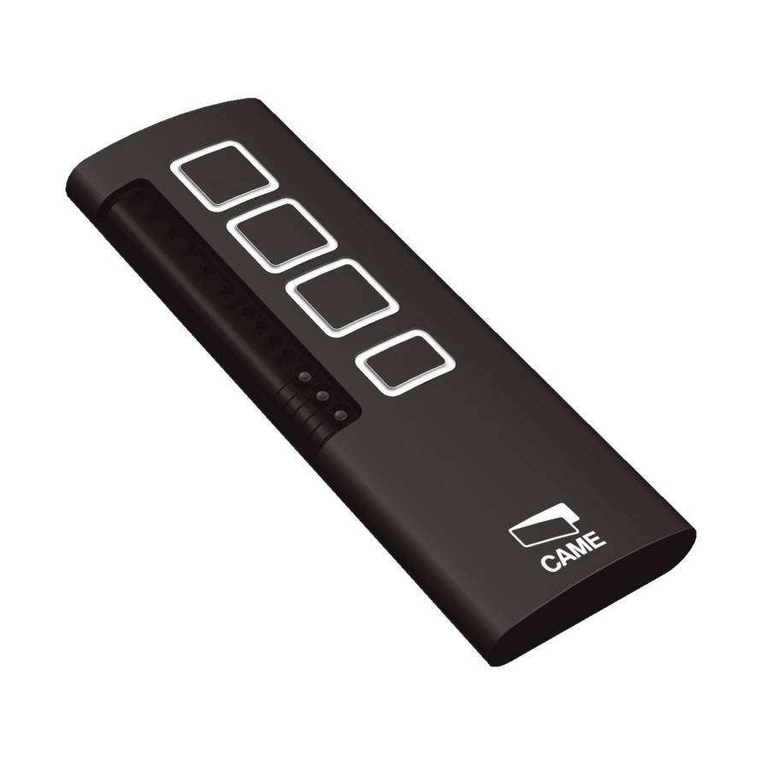
CAME
CAME STHB004WL quick guide
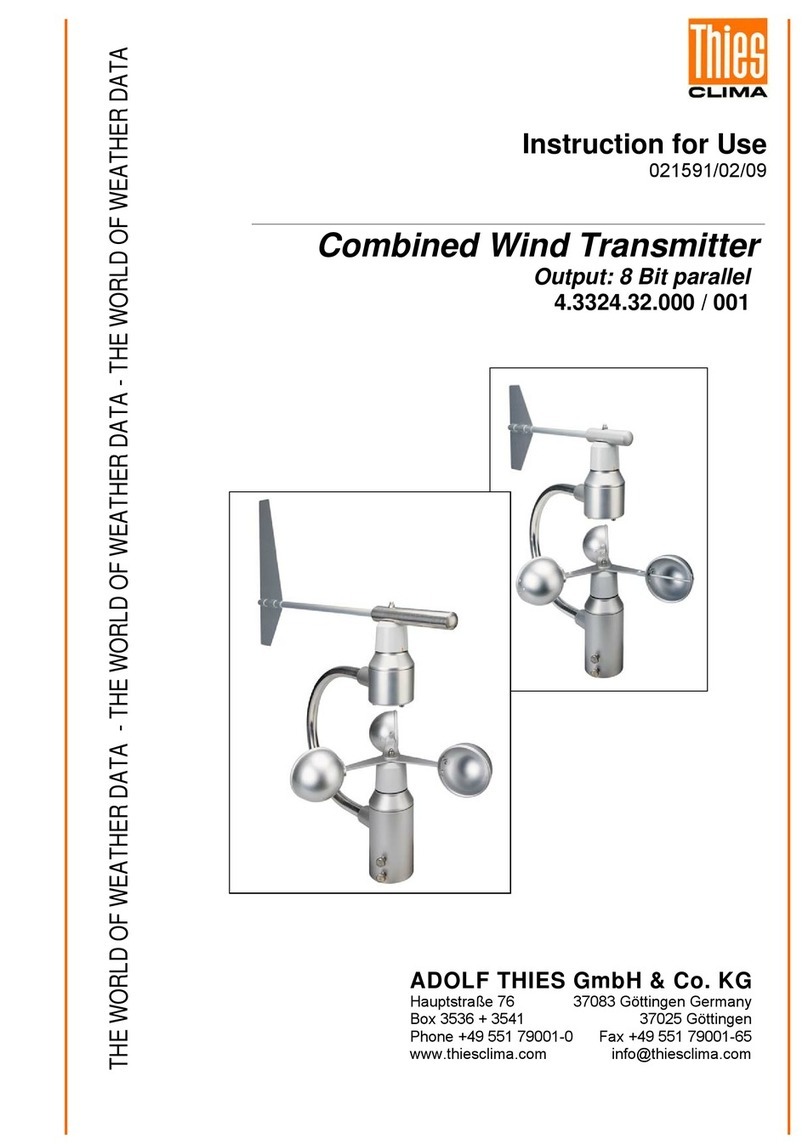
ADOLF THIES
ADOLF THIES CLIMA 4.3324.32.000 Instructions for use

Siemens
Siemens SITRANS Probe LU240 Compact operating instructions
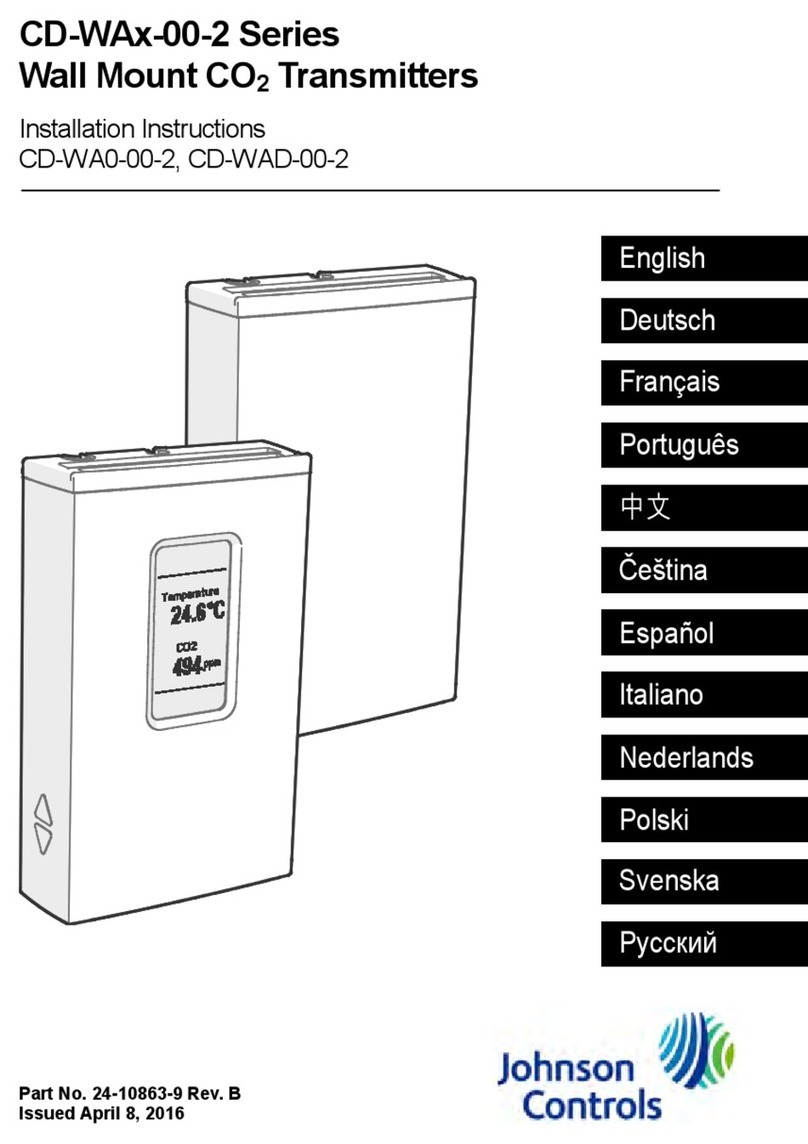
Johnson Controls
Johnson Controls CD-WA 00-2 Series installation instructions
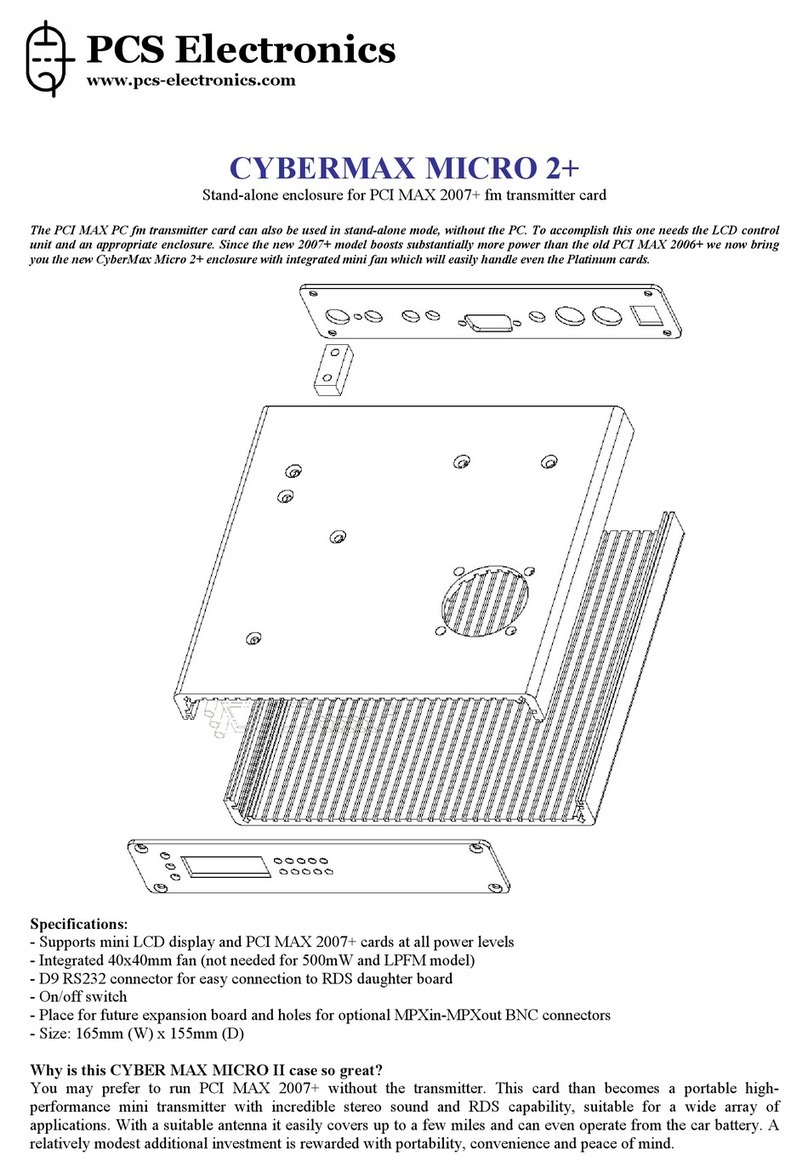
PCS Electronics
PCS Electronics CyberMax Micro 2 quick start guide

HLLY Electronics
HLLY Electronics VILLA 0.5W user manual




